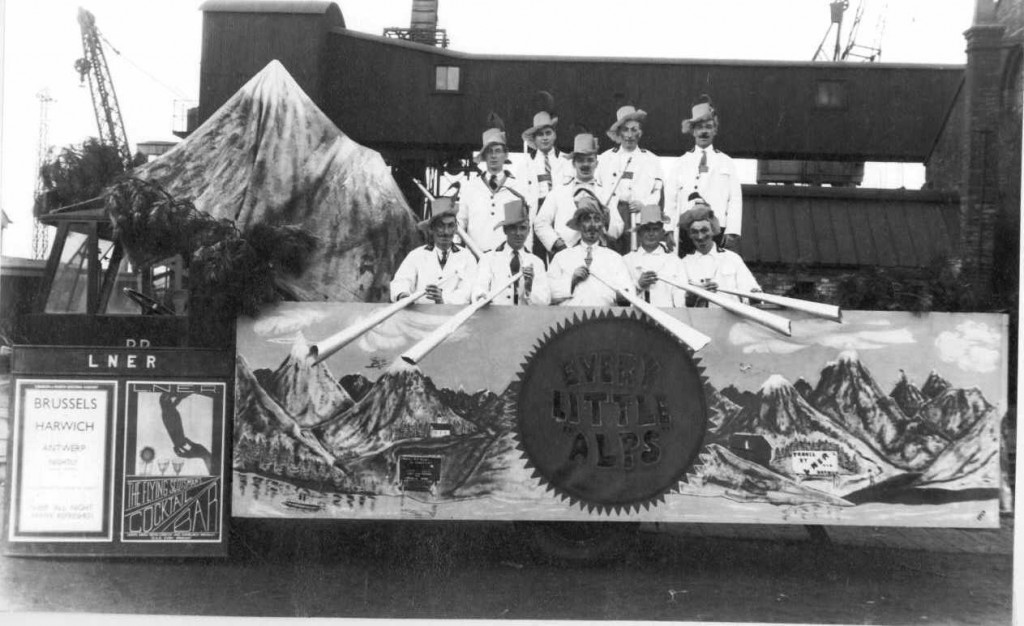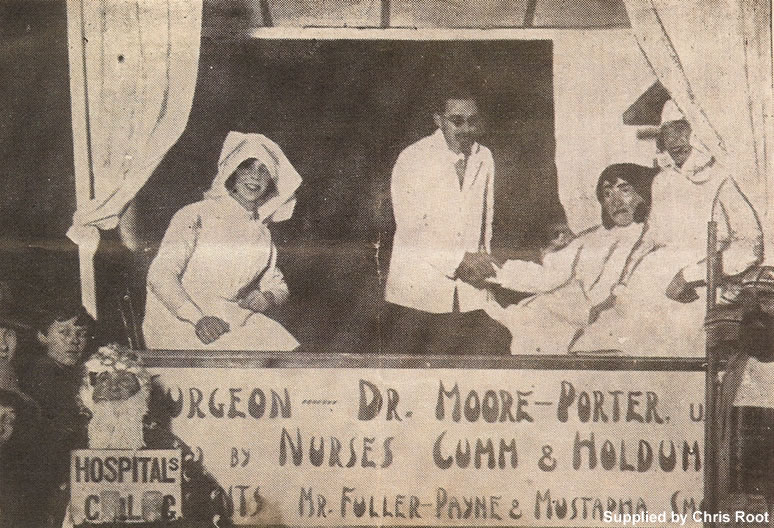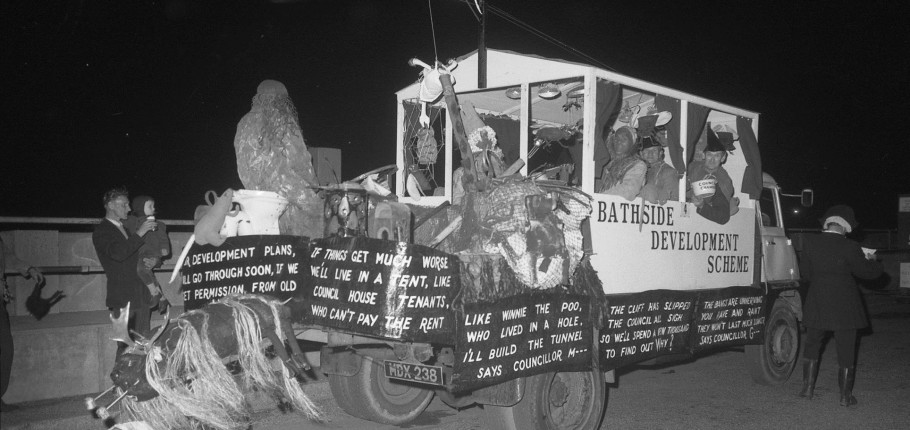
Guy Carnival
One of the most entertaining traditions in Harwich and district is the annual Guy Carnival, participated in or watched with enjoyment by many local residents and visitors each year.
Over the years the route of the procession has changed significantly, but the event still maintains its uniquely ’local’ characteristics.
History of the Harwich Guy Carnival.
The Guy Carnival started over 150 years ago in 1854 when workers at the Royal Naval Shipyard (Harwich Dock) and builders on the new quay decided to commemorate their work by holding a procession, but similar to a public demonstration, It was then called the Shipwrights Carnival and was led in those early days by torch bearers.
Some participants carried model ships with candles stuck in them and others donned “Sandwich Boards” which carried slogans and poems which made fun of their bosses (this was known as guying) And so the carnival got its name. Money was also collected in the early days and shared between The naval workers and the poor of the town.
The Essex County Standard and Eastern Counties Advertiser tells of Protestant Harwich recollecting Guy Fawkes in November 1855. The juvenile portion of the community brought out various specimens of guys and carried them through the streets, chanting ‘remember, remember the fifth of November’ This continued throughout the 1850s and 1860s, but in 1862 the annual procession had started looking more like a carnival, rather than just a Guy Fawkes celebration. Some of the people in the procession carried Chinese lanterns, torches and a number of participants wore ‘highly grotesque and fanciful costumes’. The Royal Naval Shipyard employees (now Harwich Dock) were taking part with their band and ‘Guy representations’ by 1878, they also carried lighted torches attached to poles. Earlier in the day, the children of the town had paraded their own guys.
This continued through the late 1800s and had become the Shipwrights Guy by 1890. The procession past through the streets of the town and collected money from houses, shops and businesses. The carnival, now larger than in previous years, featured many people in costumes and not just the Royal Naval Shipyard apprentices. The Shipwrights had built scale replica models of ships that had been built at the yard, reportedly ‘lighted by numerous torches and lanterns’
Mrs Margaret Doubleday, born in 1899, revealed in her 1985 memoirs that the carnival was started by the men employed by Harwich Shipyard and Parkeston Quay, who raised money for themselves for Christmas, plus local charities. Many people appeared in the same costumes year after year and the procession was headed by a brass band ‘probably the Salvation Army’. There was also a collection of lighted torches burning a substance which left lumps of burning sack in the road.
Mr Grenville Tyrell, the man who revived the Guy Carnival in 1952 and 1956, doesn’t believe the true origins of the event have, or will, ever be ascertained. He recalls seeing six foot models of fully-rigged sailing ships that were carried on a type of stretcher, illuminated from within by oil lamps and carried on the shoulders of the Navy yard employees. Some of these models were kept until well into the 1930s.
Some of the Guy Carnival pithy pars programmes from the 1930s featured photos and details of the event. In one programme they unmasked that ‘no one knew when the carnival began, but it was most certainly the Navy Yard apprentices that conceived of it. Through the ill-lit, cobbled streets the revellers meandered, their illuminated ship models of canvas, piece de resistance of the show, standing out boldly in the gloom of a winter night’.
Newspaper coverage from the early 1900s sheds no light on the carnival’s origins but stated that the procession had been a leading feature in the town for some time.
So, where did the term Guy come from?
It is agreed today that Guy means ‘to make fun of’ or ‘poke fun at’ or to ‘ridicule’. This has at least been the case since 1956, when the Guy Carnival was revived by The Harwich Round Table. The idea is to highlight something topical – a local topic, a local person or a local news item.
Before 1927 the carnival was the Shipwright’s Guy. Shipwrights were apprentices from the Royal Naval Shipyard, now Harwich Dock. There is no evidence before 1927 that the idea was to highlight and make fun of local issues or local people.
The event was sometimes referred to as the Guy Fawkes Carnival over the years.
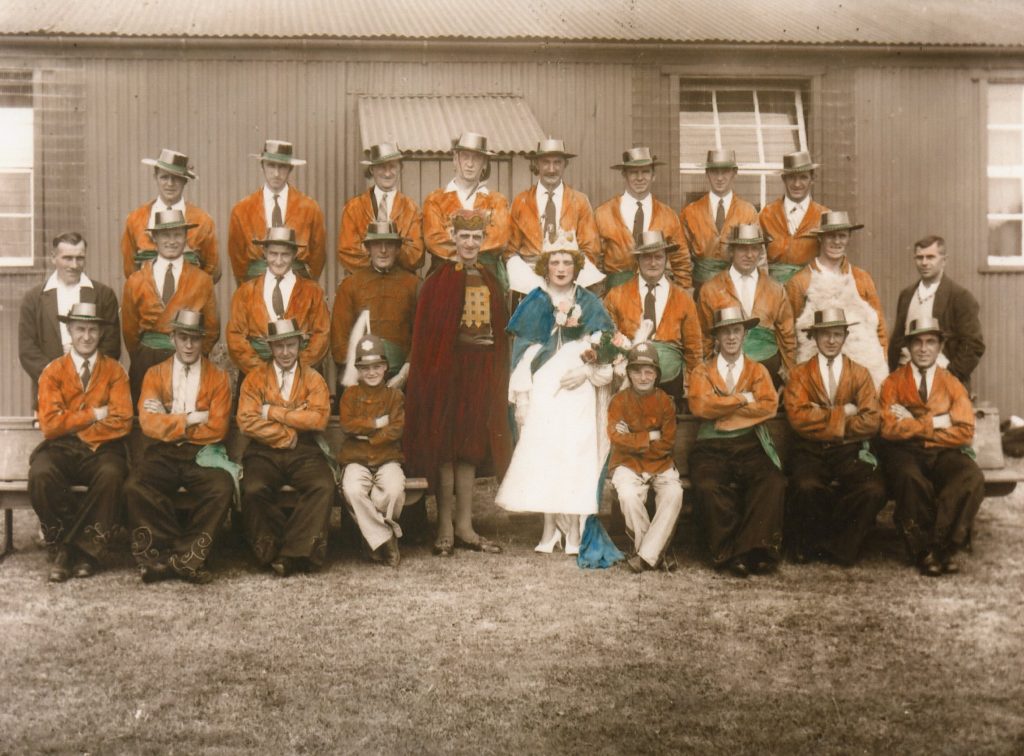
P Quay Marine Shops c.1930s
Up until 1938 the carnival was held on two dates, the 5th November (Guy Fawkes night) and the 9th November. This is another plausible source for where the term ‘guy’ originates. Ray Gladwin and Peter Wildney of Parkeston Quay Marine Workshops made the first bigheads that appeared in the carnival. Using some of the abundant materials at the quay, they constructed the heads using wire, brown ‘post’ paper and lots of papier-mâché. After the heads were built they were painted and glossed by the workshop painters.
The original crew that paraded with the Parkeston Quay bigheads were John Warner, Ken Lord, Jeff Stokes, Les Hazelton, George Harper, Irvine Richmond, Chris Barker and Derick Neal. After the 1950s the numbers of bigheads increased and were no longer just made by the Workshops at Parkeston, as people from across the town built their own.
Everybody has their favourites, but some of the famous big heads include Herman Munster, TV chef Gary Rhodes, Wallace and Grommit, Dennis the Menace, Goofy, Bob the Builder, clowns, mad cows and Dr Evil.
Carnivals in the early 20th Century (1900 – 1926)
The Shipwright’s Guy was a well-established event by 1900. It was described by the Harwich and Dovercourt Free Press as a celebration of pomp and circumstance, with many flames and fireworks and ‘sectarian spirit’. The concise little article added that the event had been a leading feature in the town of Harwich for sometime, but for exactly how long wasn’t mentioned. Despite the admirable support for the event in the early days and the respectable monies raised for the East Suffolk Hospital, it was never an official event and was arranged by the Royal Naval Shipyard employees. This is very likely the reason for its lack of in depth news coverage, with little more than a paragraph for the event at the back of the newspaper each November. However as the amount of money donated at each event increased incrementally, its charitable cause made it more worthy of a mention. £17 8s was collected in 1901, compared with £44 17s in 1903 including a notable donation from Mrs Vaux and F Napier-Clavering Esquire! The procession began in the market place in Harwich and included many people in costumes with collecting boxes, plus representations (they weren’t called floats in those days) usually carried on a type of stretcher lit by candles. Effigies of local figures were also prevalent. Advertisements for the event started to appear by 1909, when the coverage in the newspaper grew.
The community of Harwich was far more homogenous then, so it was no surprise that the pomp and circumstance included Mr W McLearon the Mayor, a pillar of the community in those by-gone days. The tradition continued into the era of King George V, supported staunchly by locals that were keen on donations to the poor, the needy and mostly the hospital. The First World War hiatus did nothing to prevent the carnival from being revived in 1919, as this was a manner of bringing much needed financial assistance for local hospitals to treat people. It also came as some relief for those who lost husbands and sons in battle. £134 was collected from the two processions and the local newspaper even printed the names of those that had kindly donated.
By the 1920s the event was larger, but still didn’t feature the topicality that it did in later years; there were representations of national icons such as kings or queens, but only with modest hints of public figures being masqueraded. In 1923 the Harwich and Dovercourt Standard believed the event ‘would ever live’, yet by 1925 the event was ‘not what it used to be’ and ‘feared over’ as reported by the same newspaper. By 1926 the event was still going, though minus the usual enthusiasm, but enough, according to the carnival secretary Mr P Skargon, to stop it dying completely. This prompted a rethink by the organisers. Taking the carnival back to its roots suddenly provided rehabilitation and the 1927 ‘comeback’ proved that Harwich people wanted the carnival as much as ever.
Comebacks.
You would be wrong if you thought that comebacks were only for celebrities. The Guy Carnival’s first ‘comeback’ was in 1927, when a committee of local traders, councillors and volunteers completely reorganised the procession. It was renamed the Harwich and District Guy Carnival, receiving plenty of support from local people and raised much money for both the Ipswich and Suffolk Hospital and the Harwich hospital. The event was still held on two nights, a tradition that was part of the original procession, one close to the 5th November and one on mayor-making day, the 9th November. The procession would feature the Mayor’s Corporation, journeying passed the house of the new Mayor when he would appear in his garden on a podium and make a short speech to the people in the procession. The rejuvenated procession with elements of the old-style carnivals brought back the community spirit and the sweet cause of charity. Pictures of the event were now appearing in the local newspapers and larger adverts were being put up about the town, which contained the Pithy Pars.
1930
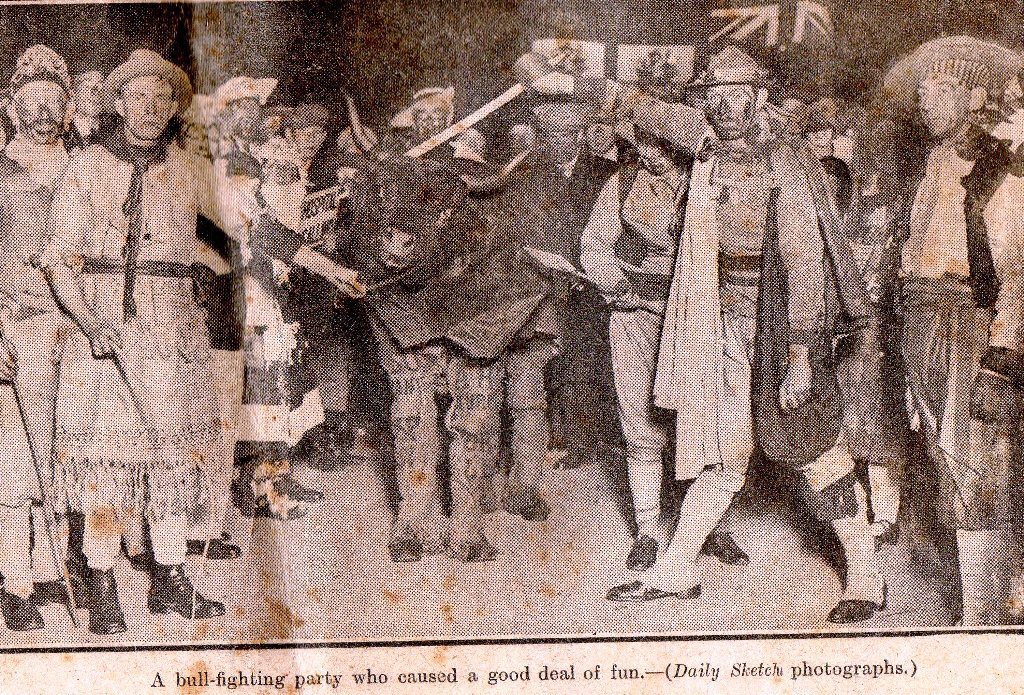
1930
The Second Guy Carnival at Harwich, in aid of the Ipswich and Harwich Hospitals, was held on Saturday 8th November 1930 with much success. The streets were crowded. The huge procession followed very much on the lines of the Wednesday night, Mr. Charles Archer again being Marshall. There were all the opening tableaux, with the addition of a most interesting one made by the captain. Officers and men of Train- Ferry No. 2. It was a magnificent model of the Ferry.
The Mayor and Corporation were represented in the procession, and at Dovercourt they made a call on the Mayor-elect (Mr. R.A. Ward), who, with Mrs Ward, welcomed them at uplands. The prizes were distributed by Mr. P.J. Pybus, C.B.E. M.P.
1931
It as reported that the total receipts for this year had reached the record figure of£ 255 13s. 2d, and expenses amounted to only £26 15s. 5d., about 10 per cent of the receipts, giving a net receipt from the 1931 carnivals of £228 17s. 6d.
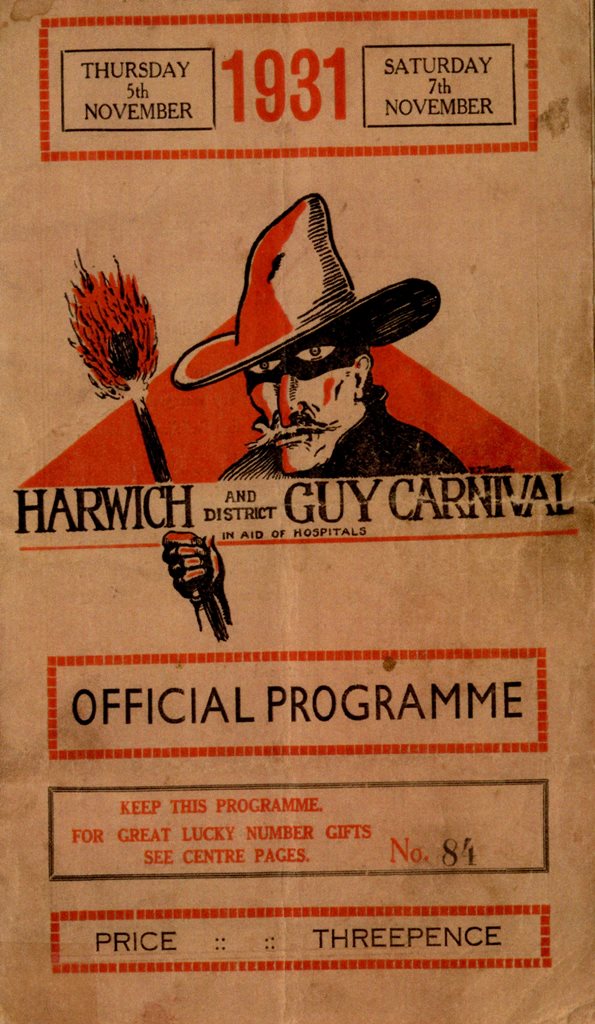
1931 Programme
“A Great Success.”
The Deputy Mayor congratulated the organisers of the carnivals. There was no doubt, he said, they had proved a wonderful success and he was glad to know that the receipts surpassed those of the 1930 carnival. He Understood the collecting boxes were down slightly, but the committee with their wonderful forethought, organised a scheme of coal tickets, and with the sale of programmes, had more than met the shortage.
Thanks were due to those generous friends who entered tableaux, and a continuance of their support was looked forward to.
He would like to refer to Messrs, Fisher and Woods “ Nunemployment Exchange” and rejoiced to know such a show could be conceived, produced and received with such good humour on all sides.
1932
Saturday night’s Guy Fawkes carnival for the Ipswich and Harwich Hospitals at Harwich and Dovercourt was a great success. The Mayor (Mrs R. Hill) was president, Mr C. Keep chairman, Mr. A.E. Price vice-chairman and in charge of the fancy dress parades, the Rev. J. S. Hole hon, collector; Messrs, E.E. Hills and Moseley were organising secretaries, and Mr A.T. Booth was general hon, sec. The tableaux included some novel designs. The men of the Trinity had a coloured dragon, 28ft long, which was “captured at Awkward Ness Beach.” and which performed snake-like evolution’s with blazing eyes and protruding tongue.
Mr. E.J. Keeble, Great Oakley Hall, had a magnificent show of British produce, and Mr. Ike Hart, the octogenarian of the carnival, introduced a scene of Old Harwich with “Custom House Alley” which formerly stood on the site of the Great Eastern Hotel. Messrs, Robinson and Reynolds introduced an excellent model of the Irish Sweep. The railway checkers representing the out-door Quay staff of the L.N.E.R., had a clever model of the Rocket 1821. There were also the usual fancy dress characters.
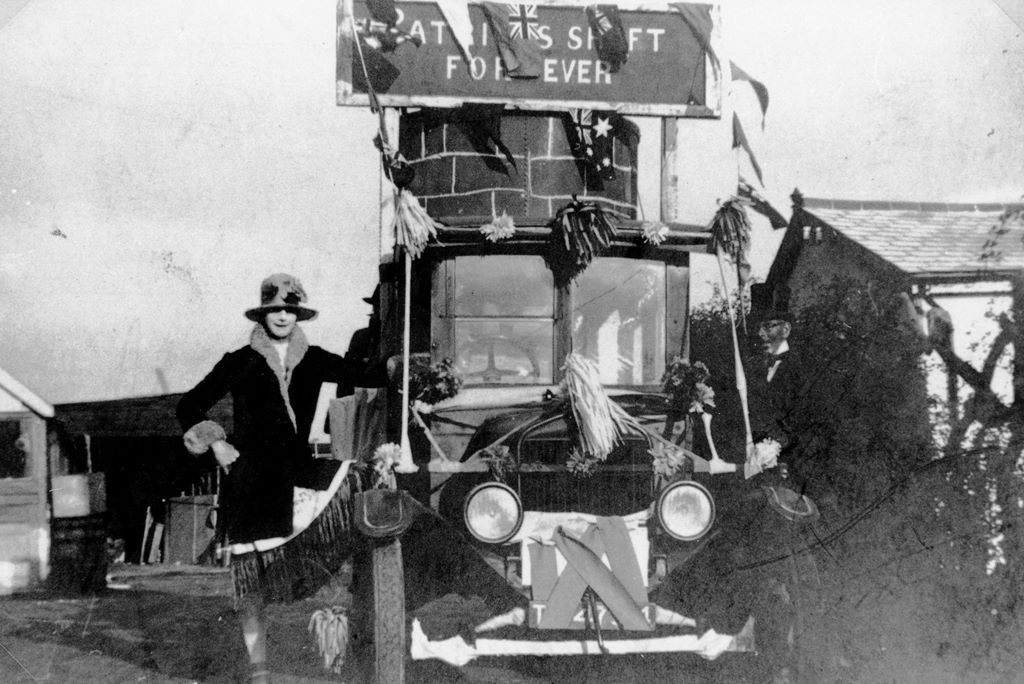
1932
This photograph was taken on the afternoon of November 5 1932, in the yard of H.H. Bradford, builder of Mayes Lane, Ramsey. The firm’s lorry had been decorated for an entry in the Harwich Guy Carnival procession with my father George Allen in “drag” to the left and Arthur Rowland” blacked up with top hat and tails to the right. The theme of the float was “Pattrick’s Shaft”, a tall chimney all that remained of a Victorian cement factory which towered into the sky at the east end of the Hangings. H.G. Allen.
1933
Thousands of people watched the 1933 Guy Hospital Carnival at Harwich for the East Suffolk and Ipswich Hospital and the Harwich Hospital.
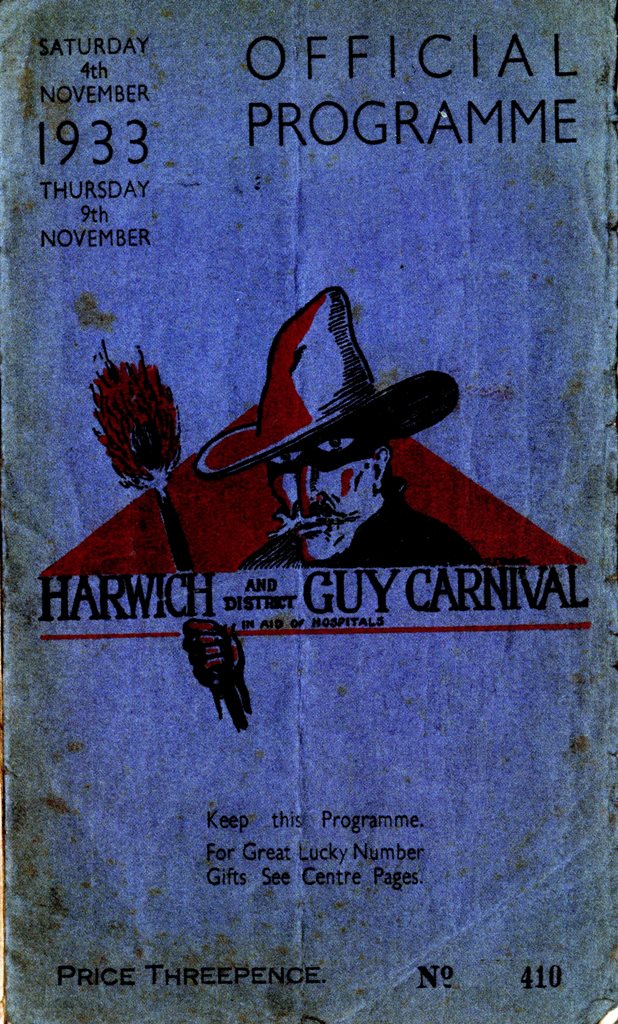
1933 Programme
At the Fountain the children were judged for fancy dress, the awards being won by Kathleen Measures, Mavis Richards, Gwen Royland, Iris Fisher, Betty Fisher, Baby Cooper, Pat Peintze, Ruby Flatt, Doris Newby, John Harris, Stanley Reason, Brian Clow, Arthur Game, Roy Moore, Eric Bennett, Raven Good, Robert Higgins, Bridie Lens, Doris Marchant. Many others received consolation awards.
1934
Harwich and district made their annual effort on behalf of the Harwich and District Hospital on Saturday when the annual Guy Carnival took place, an event that has been carried out in the borough for a large number of years.
Although this year the extent of the procession was somewhat less than has been the case in the past years following the re-organisation of the old-established annual event.
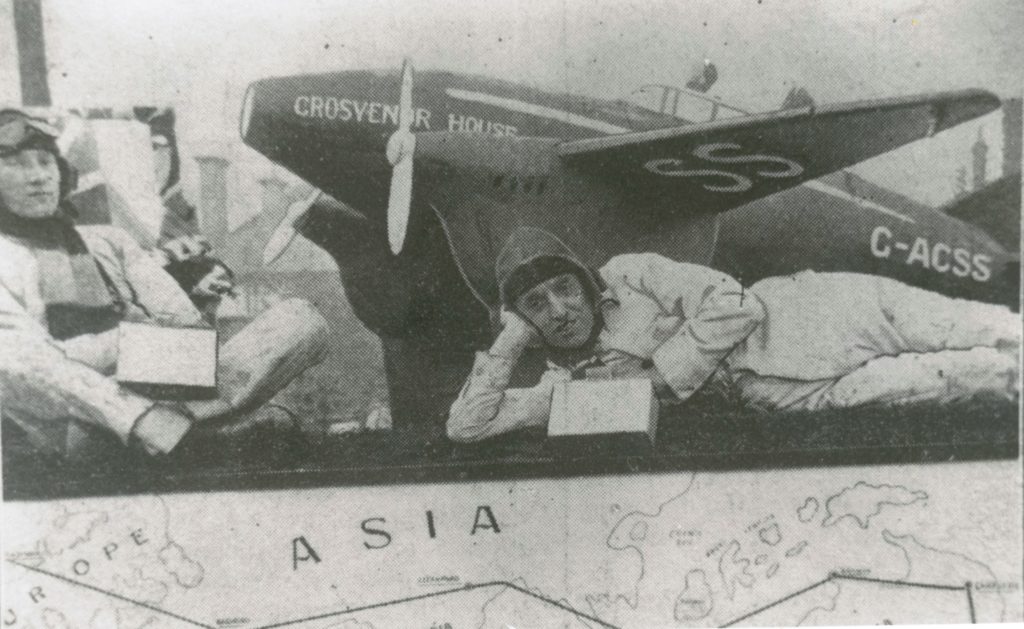
1934
There wee great crowds in the streets, especially at the stopping places, where the collectors busied themselves and particularly at the Bank Corner at Dovercourt, where there was a big crowd.
1935
Like the proverbial “old soldier,” the annual “Guy Carnival” at Harwich is an institution, it seems, that it will “ never die” , and although from time to time it is pronounced to be “dead”, it very definitely refuses to “lie down” and always revives to carry on its good work of assisting the Harwich and Ipswich Hospitals with renewed vigour.
Its origin lost in the dim of history of the past, this “Fifth of November” event is something that in the course of passing years has become deeply-rooted in Harwich and when the annual procession took place on Tuesday evening, there was evidence that the old carnival is still a virile organisation and has every prospect of carrying on for many years to come.

Fisher and Woods
The local civic authority provided the theme of an exceedingly fine entry by the staff of Mess rs. Fisher and Woods, Dovercourt, whose efforts in carnival tableaux are always very original and well-finished efforts.
The tableau depicted a “council” meeting replete with robed “alderman” and “councillors”, a bewigged “clerk” and an outside “mace” and on the “council table” a model building- “the old post office.”
1936
The second of the Guy Carnivals at Harwich, in aid of the East Suffolk and Ipswich and Harwich Hospitals was held on Monday, another large company of prettily dressed children took part in the fancy dress competition, and special prizes were awarded to John Hayward (page), Raymond Christmas (Turk), Roydon Moore (Dutchman), Brenda Rowland. Muriel Tyrrell (Victorian lady), and Joan Peachey (hearts and hands for the Hospital). Tableaux prizes were awarded to: 1, Messrs. Fisher and Woods (White Elephant): 2, Messrs. E. Saunders (Friction Library): 3, Parkeston Quay Checkers (Home, Sweet Home).
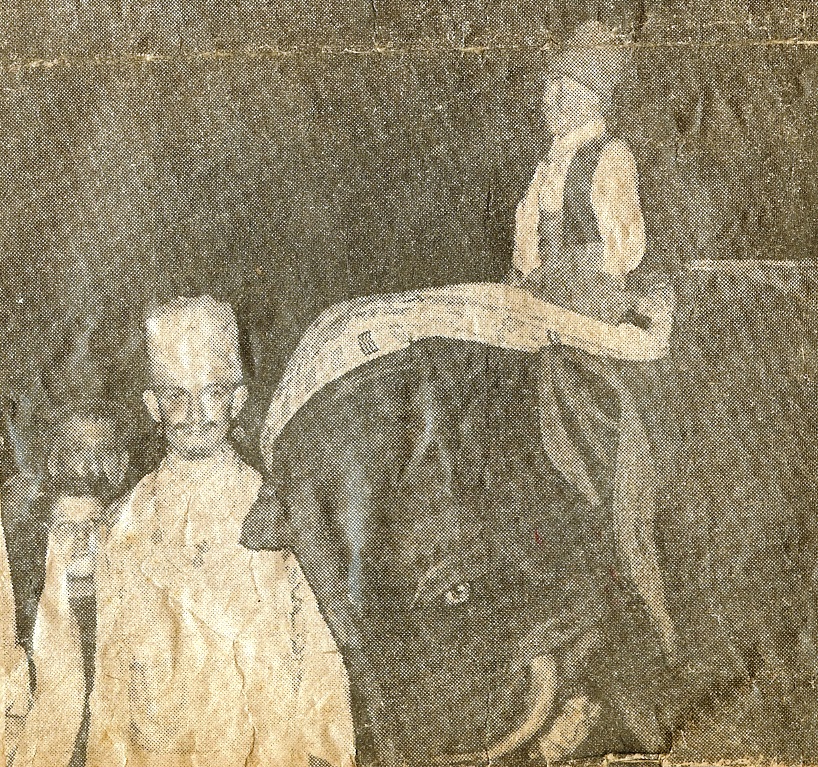
1936
1937
The carnival apparently didn’t live up to people’s expectations, with a dedicated few participating. There were beautiful and witty tableaux, and the Parkeston Pier Band introduced the King and Queen of Carnival. The prizes were distributed at a second carnival on Tuesday.
1938
The news of the burgeoning World War in late 1938 somewhat put a dent in everything a few days before the event, resulting in just two tableaux taking part. A virus had also spread in the community among local children, causing the organisers to cancel the children’s fancy dress. The Harwich and Dovercourt Standard made the bold, and premature, statement that the 1939 carnival would be bigger and better than ever. There were no more carnivals until 1945!
1945
1945 saw an attempt to revive the carnival, but so little money was raised from the first of the two processions that the second one was cancelled, despite the publicity and preparations for it.
When the carnival was brought back in the 1950s, a major feature of the procession was the Parkeston Quay Marine Workshops Band. The Marine Workshops worked at Parkeston Quay repairing ships and ship parts, and also played musical instruments. The big heads were made by the Workshops, often making caricatures of employees, as well as famous characters. The town actually had a summer carnival for many years, where the big heads would always make an appearance, and would often partake in other carnivals around East Anglia.
1951
The Harwich Standard described the 1951 Parkeston guy carnival as a “Hilarious night” with about a dozen floats taking part. typical of the tableaux featured in the carnival was the dock river showboat with members of the Parkeston social and welfare committee on board. Hundreds of “revellers donned the most grotesque costumes” and took collecting Boxes. proceeds of the event went to the “old folks Christmas fund”. Flags were strung across the streets and the weather stayed fine and dry for the occasion.
1952
Of all the things for which Harwich was ever been famous, it has been famous for its guy carnivals.
The procession which struggled like mysterious reptile over more than half a mile of the streets as it toured the town brought to local people a reminder of what the carnivals were like before the war and gave post-war children an insight into what their friends and neighbours are capable of when carnival times come.
The column was led by an ensemble by customers of the Spread Eagle, Harwich, entitled “Forgotten Shrimpers”. This was a skit on the “Down Your Way” radio programme which came to Harwich but did not include mention of the famous Harwich shrimps.
Manor-road Neighbourly Club, who won a prize in the Parkeston Guy Carnival, were again successful with their “School of Music” entry. All kinds of improved instruments from saucepan lids to makeshift horns swelled the tunes which blared forth.
1956
The Harwich Guy Carnival had yet another revival in 1956, brought back by Harwich Round Table. Gren Tyrell, who had revived it in 1952, was the chairman of the community service committee for the Table and decided that a revival of the Guy Carnival should become the Table’s fund raising project. They purchased a Workman’s Bedford Minibus for £800 and renamed it the Harwich Round Table Community Coach. Its purpose was to allow local residents to travel and see their sick friends and relatives at the Black Notley Hospital, in Essex. Mr Tyrell suggested that proceeds from the carnival could pay for the maintenance of the vehicle, but other local charities would also benefit from the money raised. A major press campaign to promote the new carnival began in August 1956, with articles appearing in the Harwich and Dovercourt Standard on a regular basis throughout September and October.
The first ever ‘pre-carnival’ meeting was held at the Anchor Hotel on 3rd October 1956, where many local firms and organisations expressed their intentions of participating. Despite the ruling by the police that the procession was not allowed to halt in the High Street in Dovercourt, the event was given the green light. Late night extensions were granted for local pubs by the Harwich magistrates, enthusiasm was renewed down at the Marine Workshops in Parkeston Quay where they had been preparing a float. A plea was put in the Standard for youngsters to come forward and carry the flaming torches to light the procession. A week before the revived carnival it seemed there was more interest than anyone could imagine!
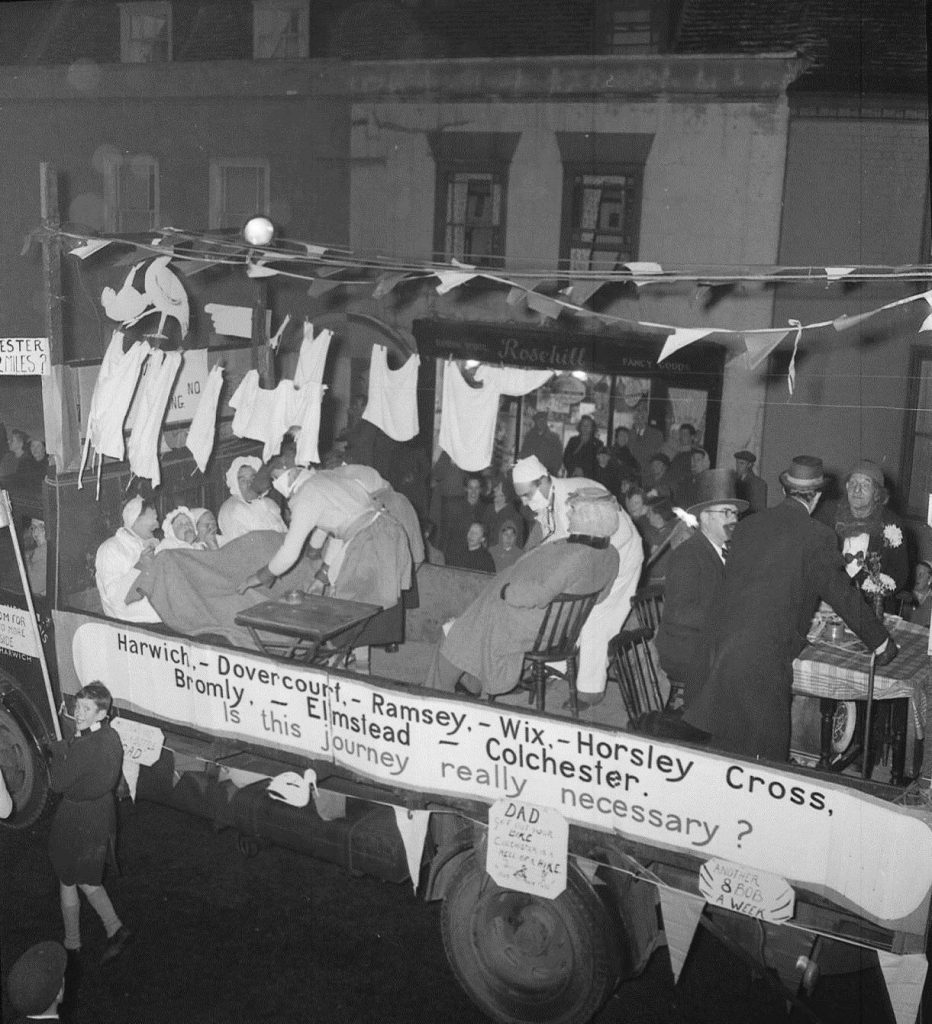
Spread Eagle Darts Club (1956)
When 3rd November came there were 25 floats, hundreds of fancy-dressers and thousands of locals lining the streets in support of their new carnival. The standard of tableaux entered was so good, that the judges made seven of them equal third! It exceeded everybody’s expectations and was described as a first-rate community effort. £192 was raised by the comeback, which eventually was divided between the Harwich Old People’s Welfare and the Harwich Round Table Community Coach. The comeback rejuvenated much support from the town. The Marine Workshops reformed their band at Parkeston Quay and played in every carnival for the next twenty years, young boys and girls flocked to help carry the torches every year and the Guy Carnival once again became one of the most popular winter events in Essex.
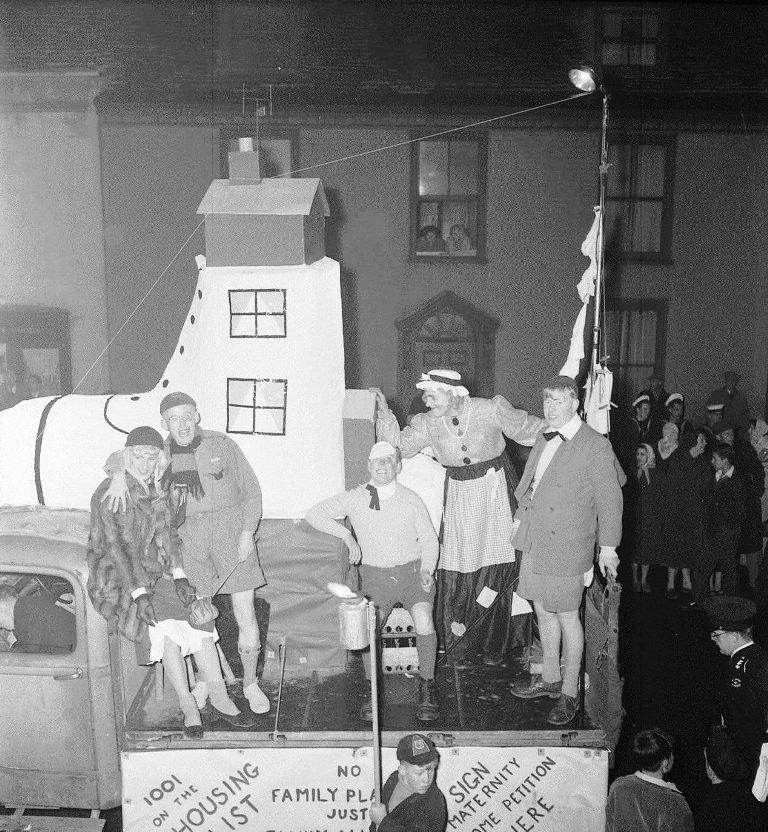
The Old Woman in the Shoe (1956).
Many hundreds of people who turned out to see the Guy Carnival procession raced home when the rain began in earnest shortly before the guy burning. Making their debut in the carnival were 41 Club who scored a hit with their tableau “Marina Mariners’ Yacht”. Which was placed first in the non-commercial class. The dilapidated “yacht” was supposed to be the first arrival in the proposed yacht marina at Harwich. “The Old Woman in the Shoe” was the subject of Harwich, Dovercourt and Parkeston Co-operative Society’s float. The old woman, dressed in flowing skirts, stood guard by her house, while her many children, dressed in long white frocks, with little bonnets on their heads, clustered around her. Many of the floats poked fun at the local council’s more controversial plans, and the bathing pool was a firm favourite.
Outstanding replica of the old Harwich wheel crane on the Green won Harwich Dock Company first prize in the large class, for the second year running.
Company employees were dressed as the convicts who used to turn the wheel of the crane in bygone days. One unfortunate “blackguard” hung from the end of the wooden crane, with the words “sacked” in white paint on his straw stuffed back.
1957
Bigger and better were truly the words to describe the 1957 Harwich Guy Carnival procession.
The first lorry in the procession carried an effigy of Guy Fawkes, which was burned at the end of the carnival on Bathside Mud.
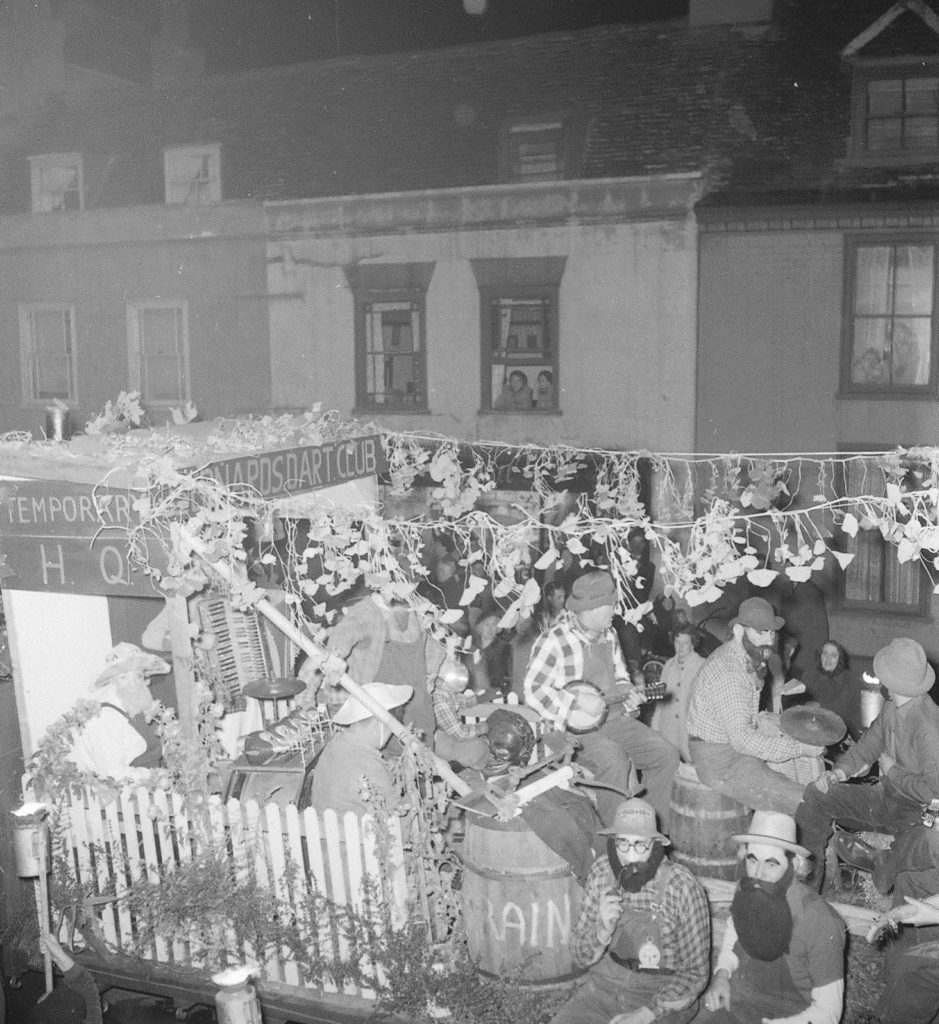
Bernard’s Darts Club
More hillbilly music rent the air on the Bernard’s Darts Club float, the members appropriately be whiskered and high spirited in array of costume and sitting amid such things as whisky bottles and gunpowder kegs.
One of the most amusing of the floats in the procession was entered by Creswell’s, the Dovercourt builders on which a crazy gang of natural comics kept up the non-stop slapstick skit on do-it-yourself decorating, The “workers” in keeping with the whole eccentric atmosphere of the carnival, got themselves into a fantastic mess, literally speaking, with such utensils as wallpaper and paste mops and brushes.
1958
Crowds of people from the town and outlying village’s thronged the streets of Harwich and Dovercourt to see the record number of carnival tableaux. The crowds were thickest in West Street, Harwich, where the procession made its first halt, but even so the centre of Dovercourt was packed with revellers.
The subjects under fire in the tableaux had been kept a close secret right up to the time of assembly. These proved worth waiting for and showed that much thought and imagination had been put in by enthusiastic firms and organisations.
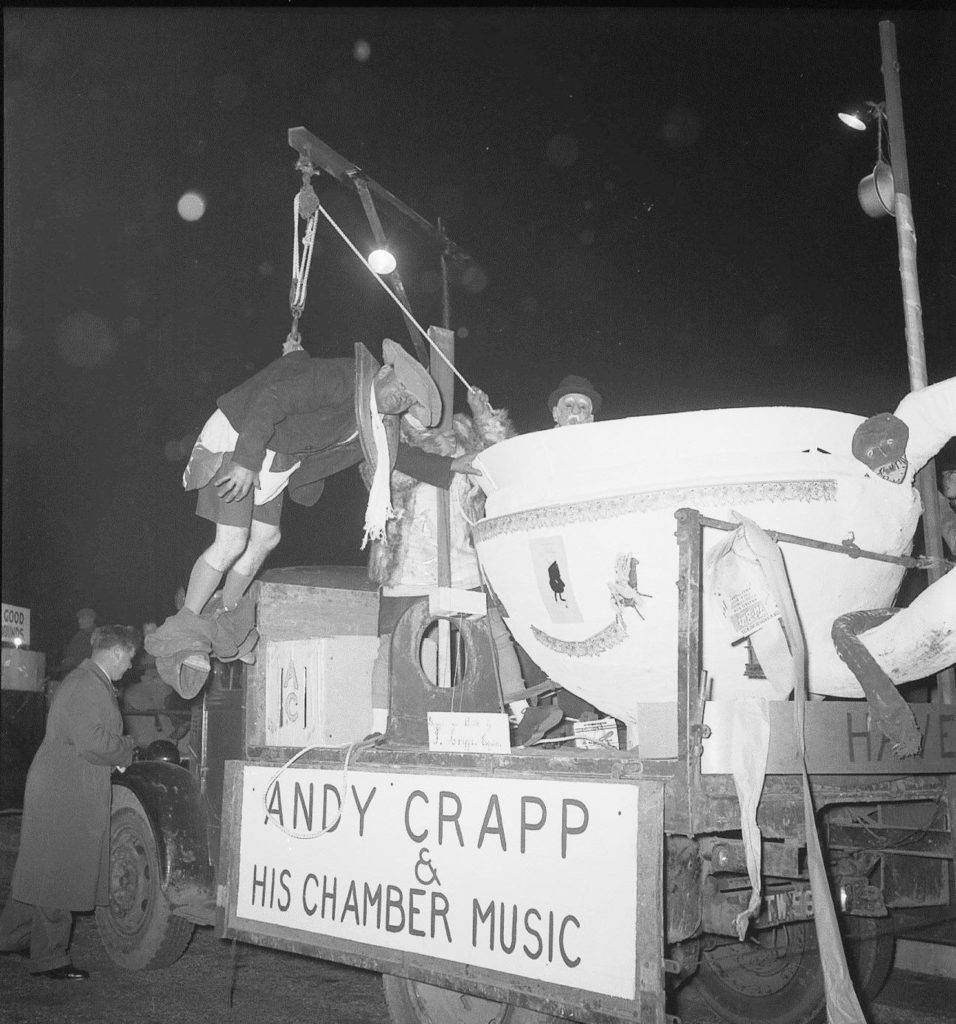
Andy Crapp & His Chamber Music
Among the most local of topics was the tableau entered by E. Saunders & Son. The float was called the “Dedham Folly” and standing on the roof, next to a signpost showing the way to Harwich, Dedham and Chelmsford, was an effigy of the Harwich county councillor, Mr. L.F. Rose.
The capers of the patients, staff and visitors inside the “Old Ladies Club” kept the crowd laughing as did the writing on its walls which read “See our local roof climber”, “Hear him on Town and Country” and “What the little old gent saw”
1959
November sees a kind of pleasant madness steal over the folk of Harwich and Dovercourt – It’s Guy Carnival time! And when this annual event took place, the gay carnival show with charity as its objective, was always, a caustic commentary on town affairs.
General theme of the procession was the decline of Harwich in that everything in the borough was closing, but although many of the tableaux depicted this subject.
Crowds of people from the town and outlying villages thronged the streets of Harwich and Dovercourt to see the procession.
First tableaux in the procession referring to the closing of the ferry, was entered by Harwich and District Sailing Club, entitled “Hurrah – No Ferry”. This showed office workers generally taking it easy, drinking “redundant tea”. The float was covered with slogans which read “It’s a better privilege by train”, “Swim if you like”, and “Never mind you, Jack, we are O.K.”
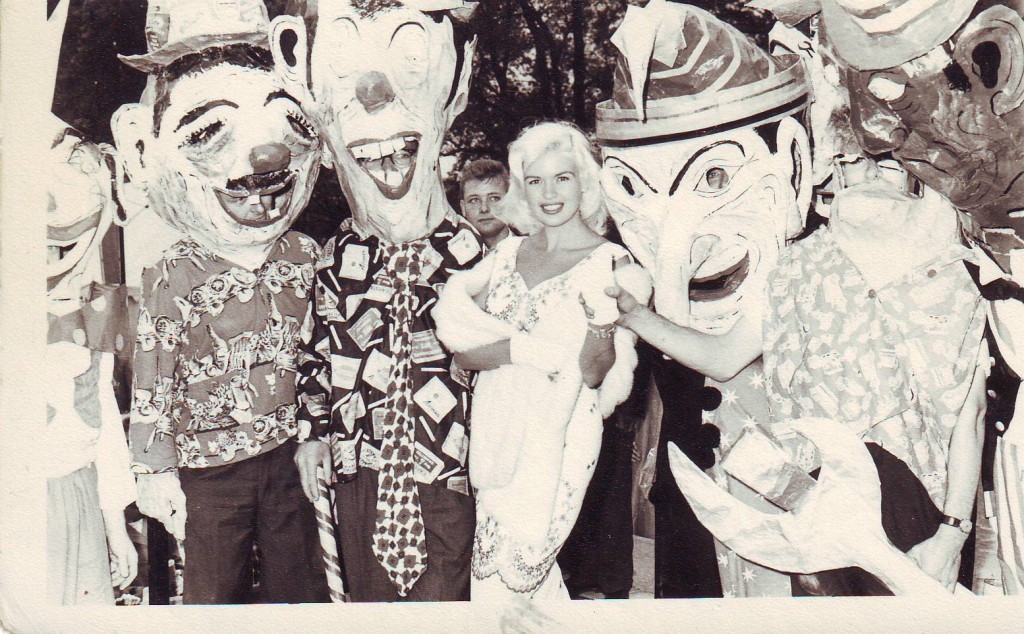
Marine Workshops Band & Jane Mansfield
This picture shows several Harwich big heads standing next to Hollywood star, Jayne Mansfield, in 1959! Big heads have grown in popularity over the years, and organisers admit that there were years when the number of big heads in the procession was thin on the ground. In 1997 Rotarian Terry Howlett made a plea for people to come forward with big heads that had been dust covered in the loft for years. The result was an increased presence of big heads.
Each year local businesses, organisations and community groups prepared their tableaux to enter in the torchlight procession. Regular participants included Tickopres, Vacuumatic, E. Saunders & Son Builders, Royal Naval Armament Depot, NALGO, Dovercourt Rugby Club, Harwich Corporation Employees group, Harwich Further Education Centre, and many others.
Guy Carnivals of the 1960’s
Over the period 1961 to 1964 Peter Westwood was directly involved in entering two tableaux’s, one from Parkeston Primary School and one from the Sir Anthony Deane Secondary School. The later comprised a skit, ‘The Hikers’ Feat’ based on an overnight hike from Dovercourt to Mersea Island that senior students had recently completed that senior students had recently completed.
1960
It was the gay and carefree face that was displayed at the Guy Carnival in 1960.
Harwich and Parkeston Football Supporters’ Club harkened back to the summer carnival preparation, and reminded all and sundry about the bill the carnival committee got from the council for watering flowers. There was even a “waterfall” on the float, as those who stood nearby at times were made aware.
The illuminated big wheel entered by Tickopress Ltd, was a focal point in the procession. Round and round went the wheel, carrying with it all sorts of figures.
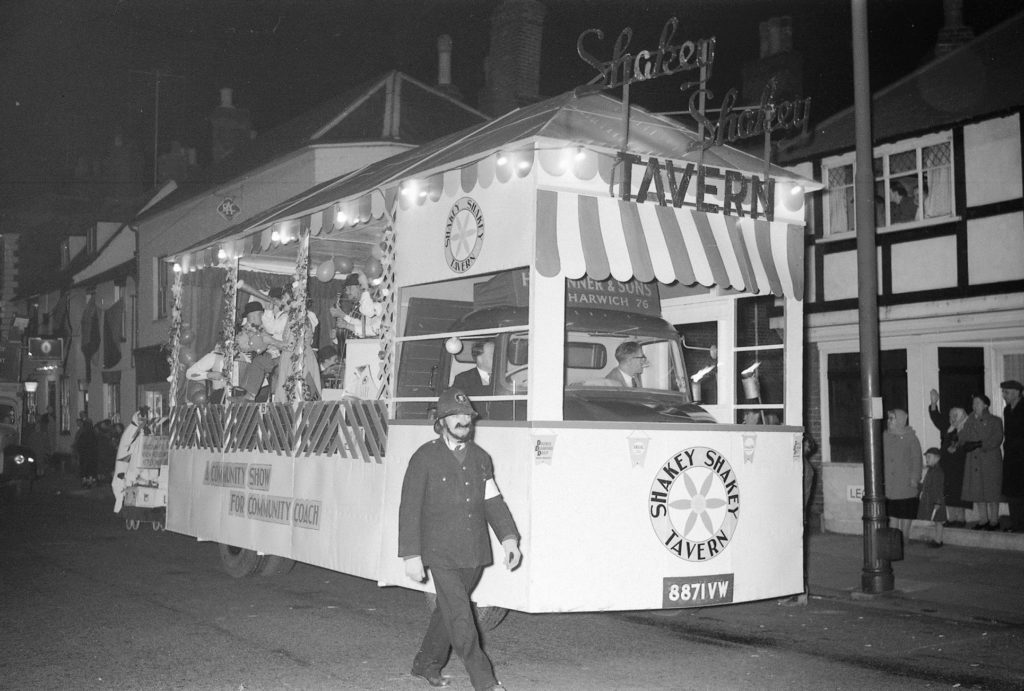
Shakey Shakey Tavern
“Calamity Coach was the entry of Mr. L. Gostling. This was a ramshackle old car and sought to show what would happen to the Community Coach if there was not enough money to keep it in good condition. Bernards Darts Club can always be relied upon for an amusing entry and this year was no exception Title of their tableau was “Dovercourt No-Bell Prizewinner 1960”. Three Spanish dancers, complete with castonettes, who somehow managed to keep that expressionless and fixed look of all good Spanish dancers, together with clowns and other odd characters, kept the crowd in fits of laughter and very large numbers gathered round the float at every stopping point to watch the3 antics of these exceptionally good performers.
1961
Harwich Guy Carnival defied the rain and took place as usual. Floats included the return of the Vikings by the staff of Harwich Dock Co Ltd, and a “Buy British” theme by Tickopres ltd.
The Guy Carnival was everything a carnival should be. It was crazy, noisy, gay and humorous. Twenty floats rolled through miles of streets led by boy torch bearers, making fire-fly traceries in the darkness. Heading the procession was parade marshal G. Tyrell, a fine figure in an old-style military costume.
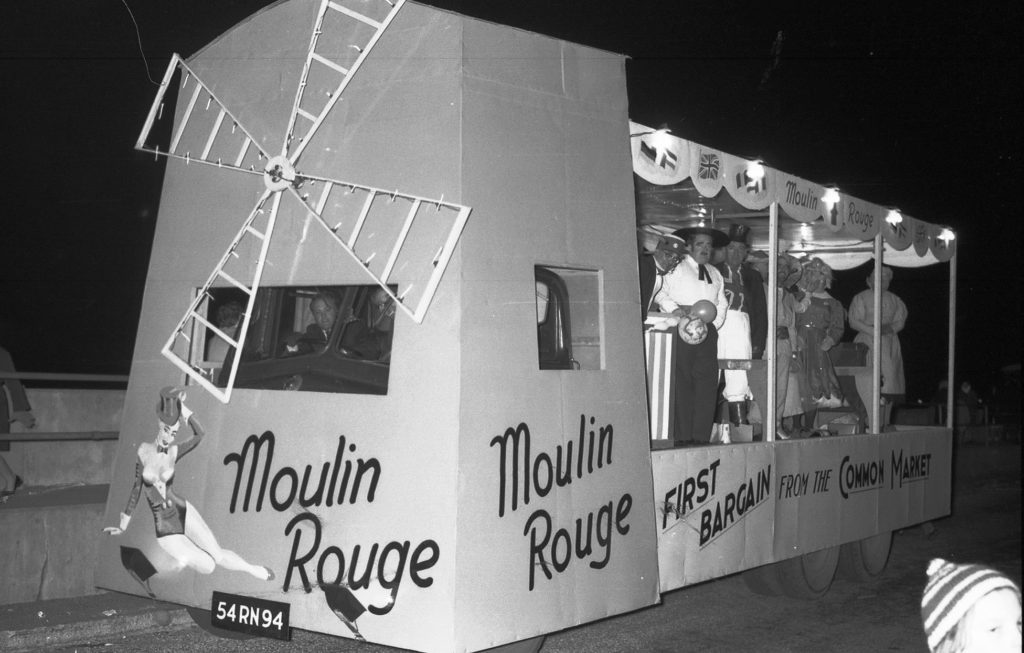
Moulin Rouge
Sheltered in their “coach” decorated with lobster nets were the Guy Gal Miss Frances Beasley and her attendants, Mrs Janice Hales, and Mrs Joan Maslin.
1962
It looked as though Saturday’s annual Guy Carnival procession through the streets of Harwich and Dovercourt was going to be rained-off. Up to 20 minutes before the advertised start time, the organisers had their doubts whether it would go on. All day rain teamed down. And then, right at the last minute it stopped, giving the procession organisers the O.K. to go ahead.
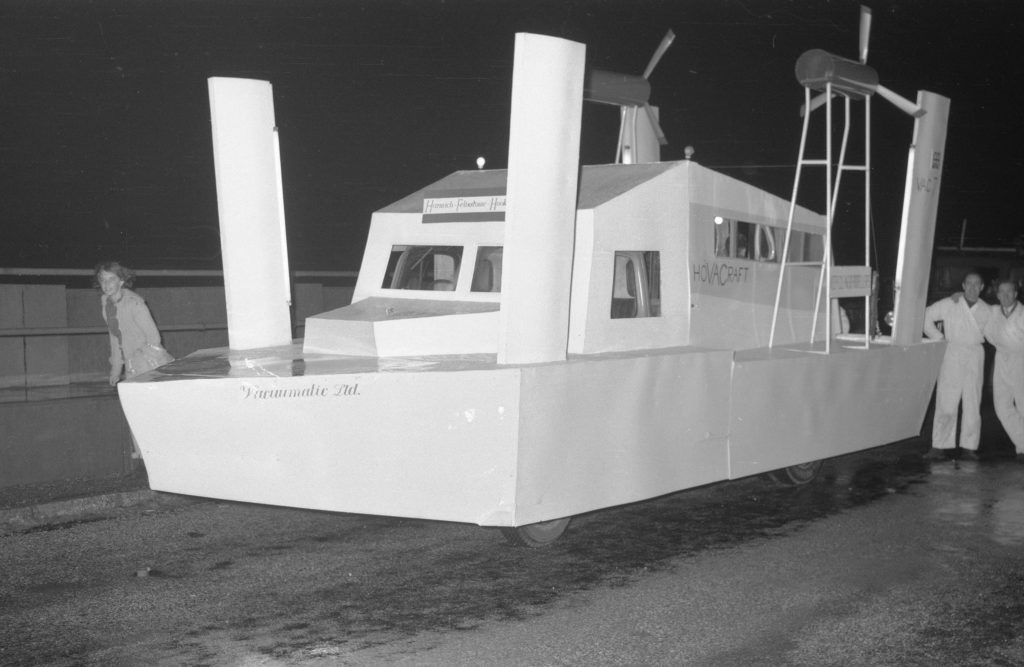
Vacuumatic
The fate of the Transit Camp was spotlighted by Edward Saunders and Sons Ltd, the Dovercourt builders. A miniature section of the camp was reproduced on the flat and a man dressed as the Mayor of Harwich was seen apparently guarding the camp, while the soldiers were “leaving for the coast”. A flashing sing at the front of the tableau read “Symmon City” and slogans such as “Join Now And See The Worst”, Vikings Stayed Here”. “Dismantle Now” and “Waste Land, What Offers?. Were displayed outside the float.
1963
Peter Westwood and Charlie Diaper provided the mobile ‘Hot Dog Stall ‘to circulate in the procession. The Hot Dog Stall was mounted on a farm trailer and towed by an unpredictable tractor. The entire journey around the route comprised a series of jerks, jolts and false starts as the tractor tried, fairly unsuccessfully, to maintain the same forward momentum as the other vehicles and the walkers. Every jerk sent hot water, hot fat and onions slurping out of the pans and on to their feet. But never mind, by the end of the evening they had made the grand sum of £ 24.11.5d on hot dogs to contribute to the Community Services Fund of the Round Table and the Community Coach Fund.
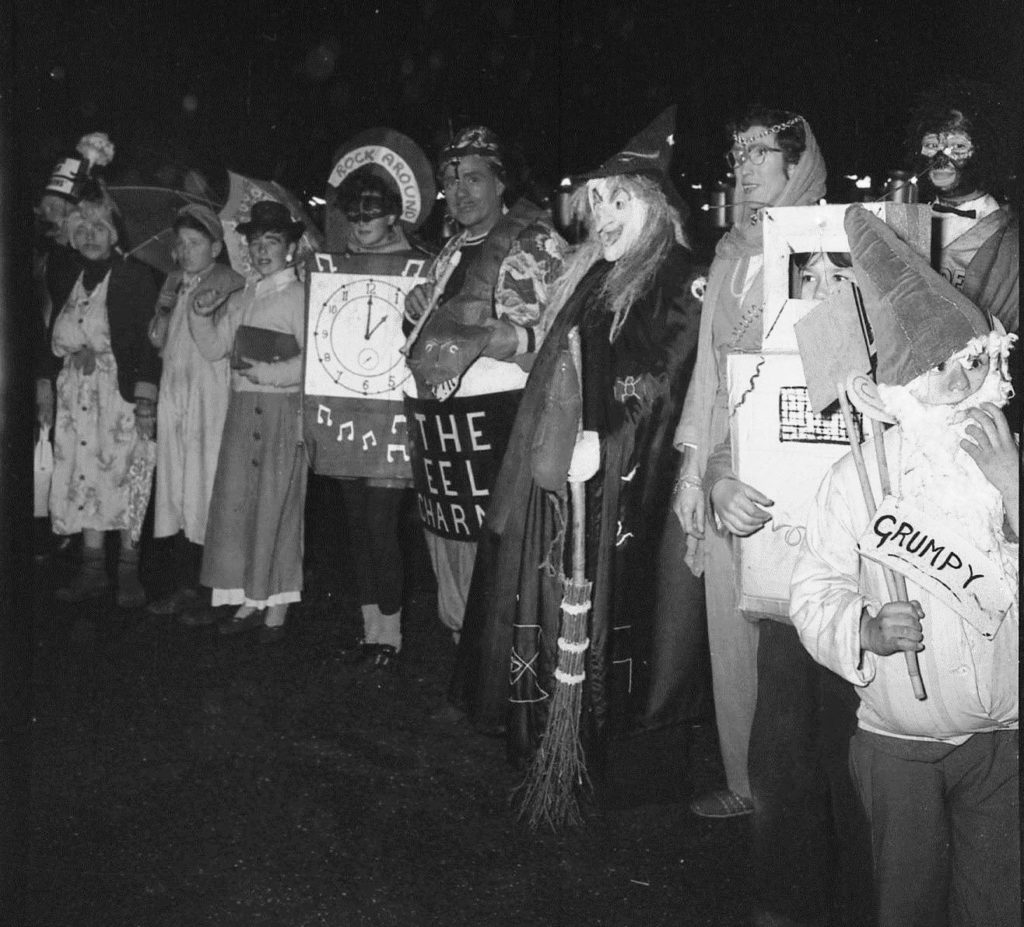
Prize Winners
1964
Harwich Dock Company, the place that started the Guy Carnival, became the place it is today in the early 1960s, when the quay was developed and renamed. It opened in Christmas 1963 and both the bosses and employees wanted to show the town that they had community spirit. Their first float in 1964 was a giant plastic model of Moby Dick, with a mouth that opened and closed, powered by a hydraulic crane. There was a small model of a car in the mouth of the whale, accompanied by jets of water that sprayed from the whale’s mouth. They are renowned for their magnificent float entries over the years, and eventually built up friendly rivalry with fellow carnival entrants from Parkeston Quay and The Vacuumatic.
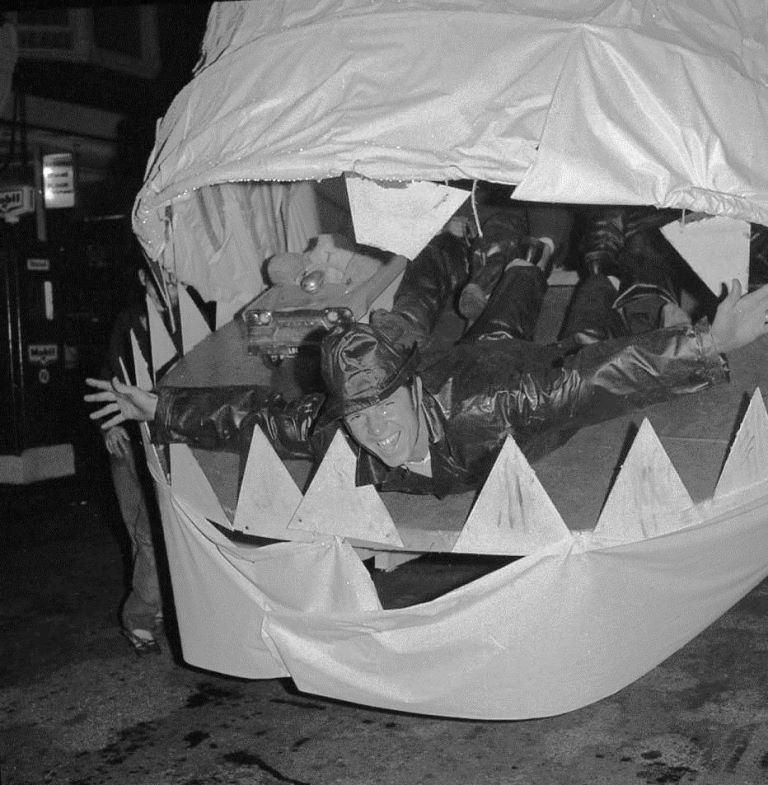
Moby Dick (1964)
The three of them were large companies that could afford to spend lots of money on extravagant props for their floats. The Dock’s tableaux were so good they were even asked to enter floats in other carnivals in Essex.
1965
Crowds of people left their warm fires to watch and take part in the annual Harwich and Dovercourt Guy Carnival, culmination of weeks of hard work by an enthusiastic committee.
Although there were not as many floats this year the standard of many was extremely high and the crowds showed their appreciation by filling up the collecting boxes.
Many of the floats poked fun at the local council’s more controversial plans, and the bathing pool was a firm favourite.

Harwich Dock Co
Outstanding replica of the old Harwich wheel crane on the Green won Harwich Dock Company first prize in the large organisation’s class, for the second year running.
Company employees were dressed as the convicts who used to turn the wheel of the crane in bygone days. One unfortunate “blackguard” hung from the end of the wooden crane, with the words “sacked” in white paint on his back.
1966
The streets of Harwich and Dovercourt were packed on Saturday evening when the Guy Carnival procession once again wended its way around the borough. Floats were bright and of high standard, the only disappointment was heavy rain which washed out the latter part of the programme.
The recently-introduced restrictions against water-skiing in the harbour were highlighted by Harwich Town Sailing Club Mrs Betty Holbrook was towed along behind a speedboat and accompanying written comments were “Wildman’s best catch of season” and “It’s fine for skiing anywhere at Dovercourt Bay”.

Harwich Town Sailing Club
One of the most enterprising efforts was by the Grange Youth Centre. Entitled “Batmobile 1932”, it depicted the Dynamic Duo with a rather antiquated vehicle. They were accompanied by Chicago-style gangsters complete with tommy guns.
Do-It-Yourself was the theme of Goslings entry. Helpers were decorating a large wall and a caption read “Drinka Pinta Painta Day”.
1967
Harwich Guy Carnival defied the rain and took place as usual. Floats included the return of the Vikings by the staff of Harwich Dock Co Ltd, and a “Buy British” theme by Tickopres ltd.
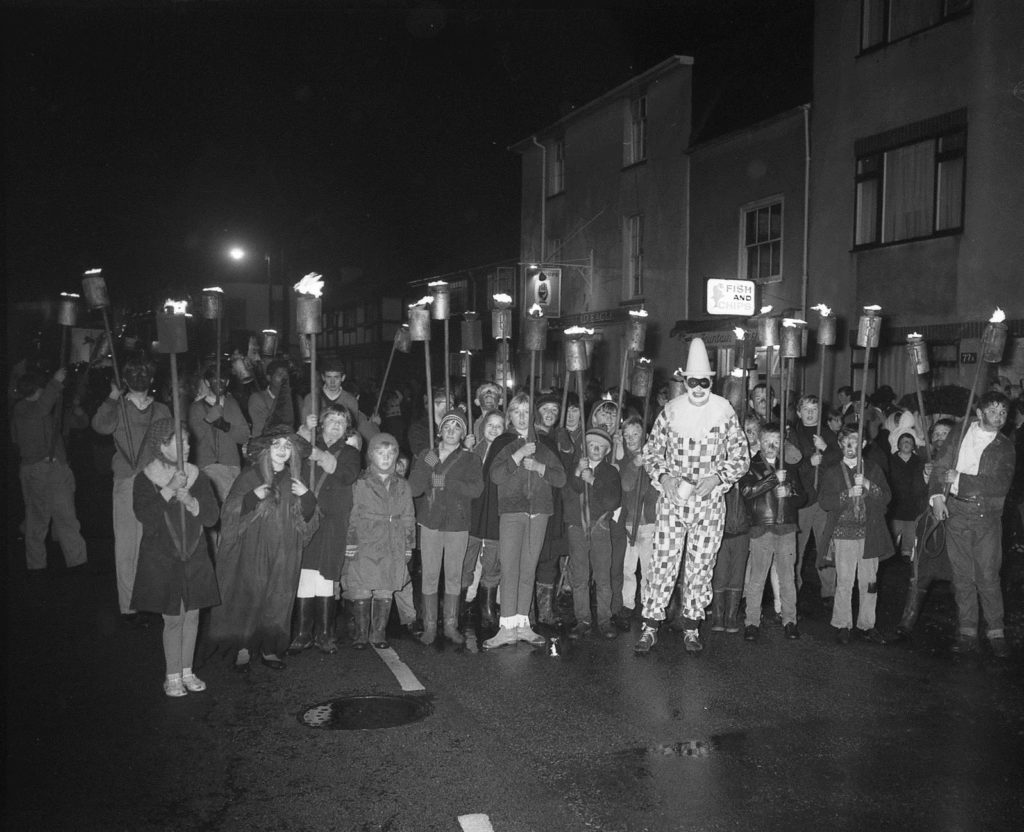
Torchbearers
Sheltered in their “coach” decorated with lobster nets were The Guy Carnival was everything a carnival should be. It was crazy, noisy, gay and humorous. Twenty floats rolled through miles of streets led by boy torch bearers, making fire-fly traceries in the darkness. Heading the procession was parade marshal G. Tyrell, a fine figure in an old-style military costume.
The Guy Gal Miss Frances Beasley and her attendants, Mrs Janice Hales, and Mrs Joan Maslin.
1968
A Cold, but dry Harwich and Dovercourt was lit up well and truly, when one of the largest and most successful Guy Carnivals of recent years, processed through the streets of the town illuminated by flaming torches, in true carnival spirit.
Some 22 decorated floats, flanked by bigheads, torchbearers, and collectors in fancy dress paraded in front of their fellow townsfolk in a whole hearted attempt to raise money for the Harwich Round Table Community Coach Fund, and the Community Services Fund.
The carnival was escorted round the town by 78 torchbearers, Music was provided by the Church Lads Brigade- giving a first public showing of their smart new white helmets and the ever-popular Marine Shops Band, who, with their usual high standard led the procession.
Topical subject chosen by the Rotary Club for their first ever entry in the Guy Carnival was “Make Life Easy For a Dustman”. Guying the bags being provided at Christmas and the dustbin liners which will make the dustman’s job easier, the float was equipped with reclining chairs and a Rotary Club view of a dustman of about 1970, complete with pinstripes and a bowler hat.
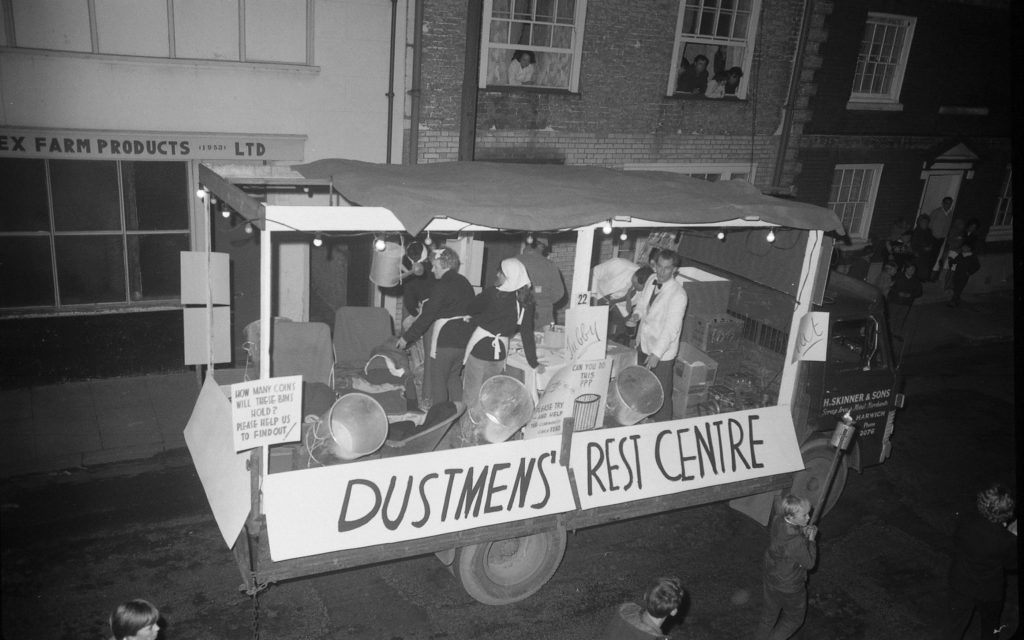
Rotary Club
Mrs Joan Maslin, became “Miss Guy Gal 1968” at a dance organised by Harwich Round Table at Warner’s Holiday Village, Dovercourt
Nalgo members had a topical tilt at the “exploding Belisha beacon”.
1969
Once again, Harwich Round Table flung out the challenge to local people to “guy” their neighbour, and they responded in strength. It was a good-humoured procession of floats tilting at people who had got into the “News” during the year, and everyone knew it was all about.
There was a special prize in the fancy dress completion for 72-year-old Mr Frank Skelton, of Lime Court, Dovercourt, who appeared as “The Man Who Broke the Bank at Monte Carlo”
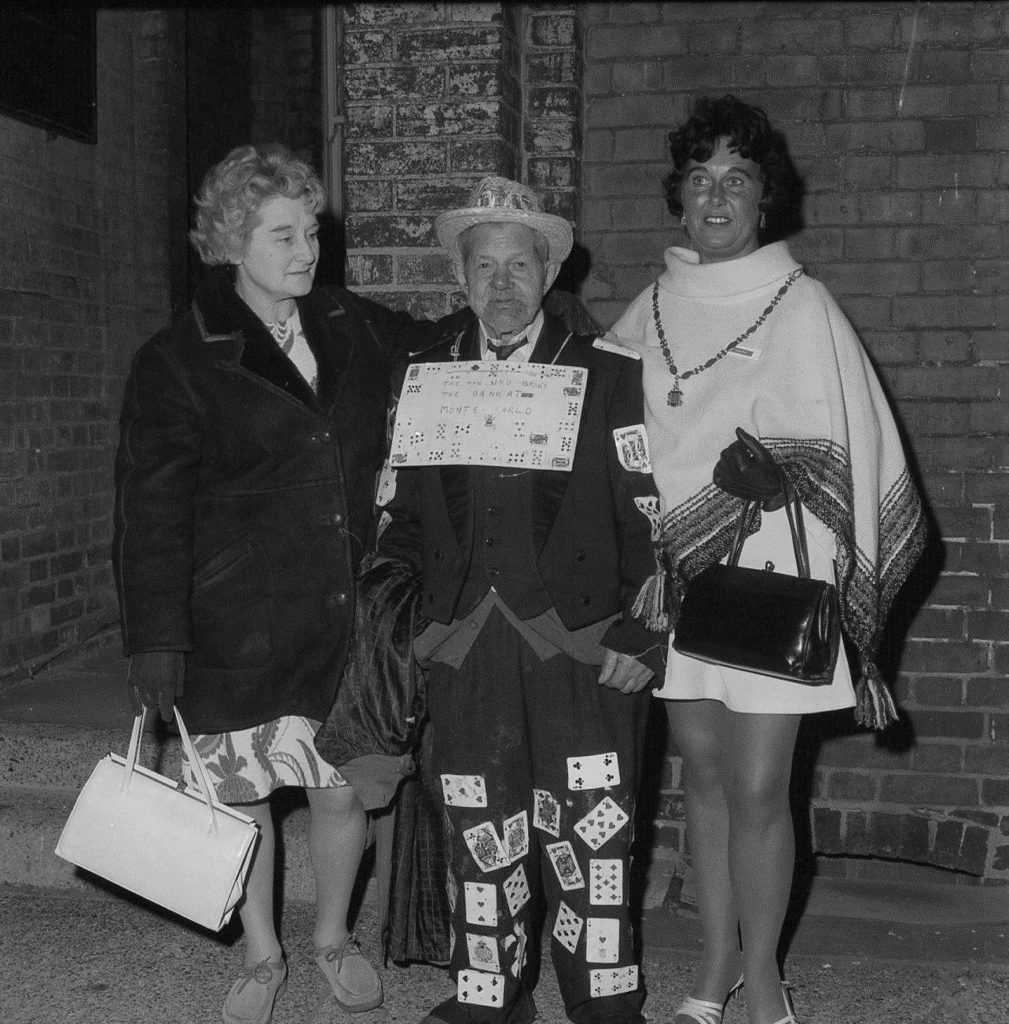
Mr. Frank Skelton
Grange’s “Wind of Change” was one of the floats that guyed the growing cult of the hippy. Short skirts, long hair, moustaches and gaudy clothes, the Grange float had them all as the further education centre members posed as hippy squatters.
Masheen, The float was built by four volunteers with help at times from the rest of the staff. Although a generator failure threatened to delay the float reaching the assembly point, this was rectified just in time to get into position for the “off”.
1970
Bigheads in assorted shapes and sizes were again the feature for the 1970 Harwich Guy Carnival procession.
Parkeston over 20’s Club turned to a well-known television commercial for their float, and reduced Home pride to Harwich Pride. They had “praise” for, among other things, the holes in the road, the cliff falls, the local football team, local transport and the local newspaper.
Dovercourt Skating Club took the opportunity to advertise the club, while at the same time encouraging members of the public to throw their coins aboard the float for the Community social funds. It was noted that 240 miles had been skated for charity by club members.
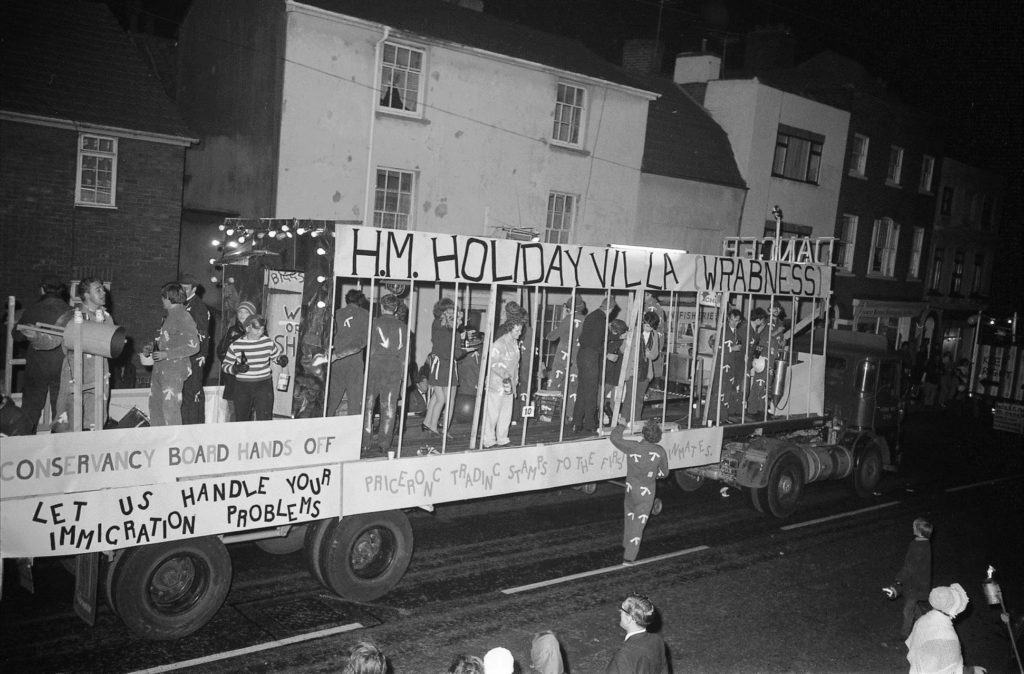
Wrabness Prison
The opening of the new supermarket provided an incentive for one of the slogans which read “Price-rong trading stamps to the first 100 inmates of the Wrabness Prison”.
1971
Hundreds of people stood about the draughty streets of the town waiting for the sight of flaming torches borne by enthusiastic boys at five pence a time, and the grand sight of monster exhibits, all noise, light and bluster.
Once again the hardy annuals came out with their floats to help the town’s good causes.
It is said locally that if you count for anything you will find yourself guyed in the carnival. One who was well to the fore was Mr Leonard Rose, who really received the treatment.
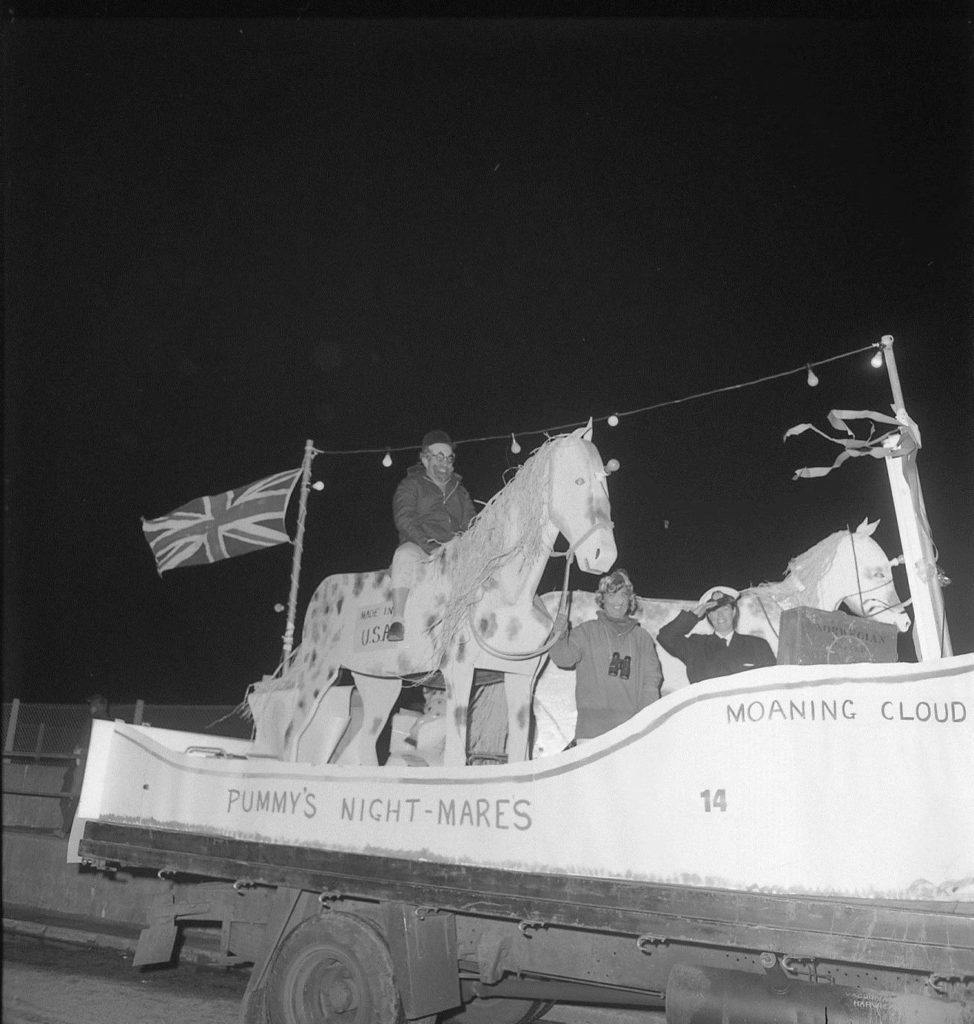
“Ponda Rose-A”
A good sport, he stood on the side-lines and chuckled as floats and characters had a dig at him. There was “Pummy’s Ponda Rose-A” or Pondersoa is a scheme he has in hand for a log cabin motel at Parkeston.
Mrs Betty Holbrook, former Mayoress and leading local helmswoman, hit a topical note with her float shared with friends. She was steering the yacht “Moaning Cloud” towards England carrying “Pummy’s Night Mares.”
1972
Hundreds of onlookers turned out for Harwich’s traditional fun-poking Guy Carnival.
And in the customary style the majority were aimed at satirising current events on both a national and local level.

Electric Palace
Main victims this year were the Cod War, the preservation of the former Electric Palace cinema and political affiliations of Harwich alderman, Mrs Georgina Potter. And ironically Mrs Potter was one of the five float judges who voted the entries by individuals and small groups and the best for local topicality.
The Vacuumatic entry featured a confrontation between a trawler and an Icelandic gunboat, while the Winnick entry, also on the same theme, punctuated its progress along he route with loud salvos from a gun.
1973
Harwich Guy Carnival was reported as the best ever, with a record of over £ 1,000 expected, outstanding floats and enthusiastic crowds enjoying the traditional fun-poking event.
Supply the glamour in the procession was the Guy Gal, 15-year old Debbie Flatt, with attendants Janice Self and Jenny Rogers, who were the head of the line of floats.
The majority of floats were aimed at satirising current events, Norprint Social Club’s shortage of milk bottles to the local issue of a bonus for road diggers.
Strangely a most topical subject – the forthcoming Royal Wedding – was represented by only one float entered by Carless, Capel and Leonard. Called The Royal Jump, it won the Round Table Shield for the best large organisation entry.
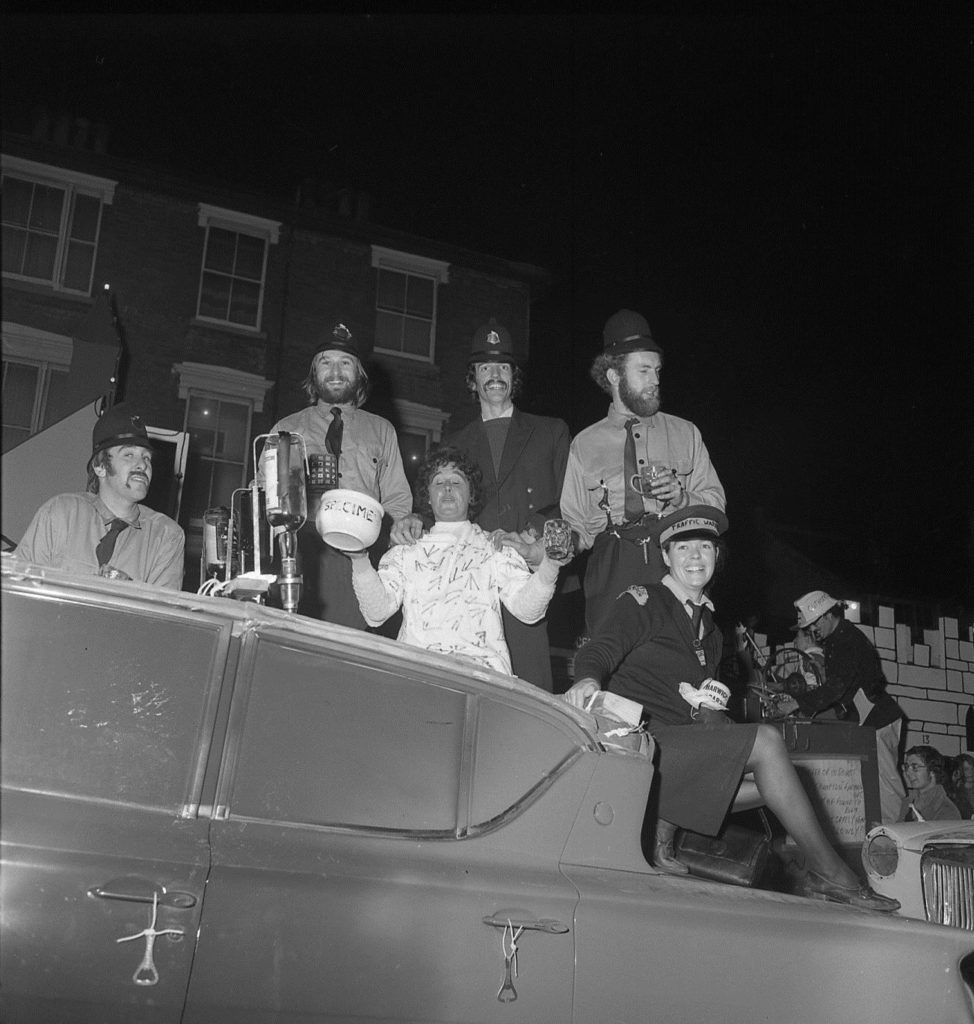
Betty Holbrook
The Hostler Cup for small groups or individuals was won by the Topical Three for the second year running; Mrs Betty Holbrook won the Doug Jennings Trophy for best topical entry. Winner of the adult’s fancy dress was Mr K Horniek, as a spaceman.
1974
Harwich and Dovercourt once again proved that live entertainment can bring the people out in their masses as on Saturday evening, despite intermittent rain, the biggest event of the year got under way.
Once more, the British were celebrating the near-downfall of Parliament five centuries ago and the police and a detachment from the Army were in the forefront of the torchlight parade to mark the efforts of the man who never made it – Mr Fawkes.
The Big Heads, the Marine Shops Band, some 107 children carrying flaming torches and others armed with collecting boxes, headed the procession on its tour of the town.

Guy Carnival prize winners
Two groups chose the sugar shortage as their theme, with the apprentices and mechanics of Central Garages and Bay Motors being placed first in Group Two for their Sugar Security Service tank, and apprentices and youth of Vacuumatic winning third place in Group One.
Setting the atmosphere for a guy Gal dance, Harwich Ladies Circle float was gaily decorated with balloons, with members’ children dressed up, the girls as attendants and the boys as a pop group. The members themselves were the contestants, including Miss Harwich Harbour, and there were also three judges.
1975
The Navyard Wharf built a scene from Disney’s Snow White and the Seven Dwarfs and showed the dwarfs repairing the holes in the streets of Dovercourt. In 2000 they sent Thunderbirds 1, 2, 3 and Lady Penelope’s pink Rolls Royce along to save the town from bad weather, floods and poor public transport. In 1978 they decided to use Star Wars to somehow highlight the plight of Dovercourt swimmers, for which they picked up a prize. Their 1998 float entry was a magnificent pirate ship, complete with crocodiles, guns, mast, smoke and pirates. They were poking fun at ferry company Stena, whose High Speed Ferry had experienced many mechanical problems that year.
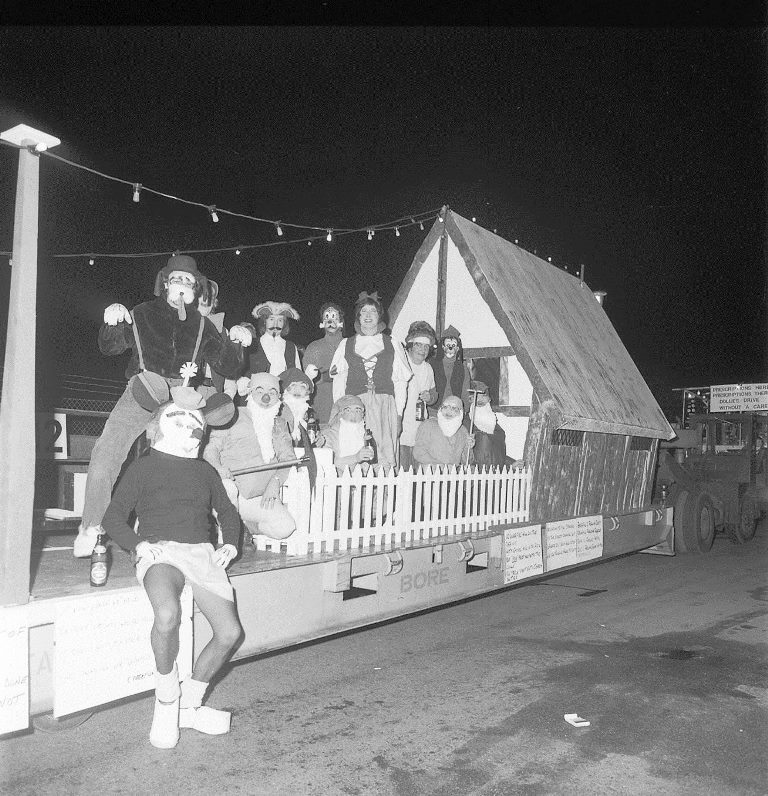
Snow White and the Seven Dwarfs
One of their slogans said ‘From the Caribbean we made good speed, we heard that Stena was in desperate need, of another ship to do her run, so sail with us and have more fun!. Other Dock themes have included a replica of the Tread wheel Crane, the children’s television show F Troop, Paint Your Wagon, Robin Hood, Julius Ceaser, Dad’s Army, Trumpton, Harwich’s Saint Nicholas church, ‘Pummy Rose’, the battle of the Chinese take-aways and in 1983 they made a wonderful, life size model of a paddle steamer. It took them nearly three months to make and rumour has it that someone from the Ministry of Transport had to visit the dock to ensure that the tableau was safe!.
1976
If There’s one thing Harwich folk enjoy it’s their annual Guy Carnival – and 1976 was no exception.
Thousands defied damp and drizzle to line the route and boost the street collection to well over £ 1,000 more than the record.
The carnival procession gathered in Stour Road and was led by a Community Coach, driven by last year’s Guy Carnival chairman, Mr Neil Mcrone.
The Marine Shops Band followed and paved the way for the floats and provided music throughout the route.
The band was followed by Harwich and Dovercourt Carnival Queen Catherine Hodgson travelling sedately on a replica of British Rail’s Sealink ferry St Edmund.
Next came the Ladies’ Circle depicting the popular topic of Prince Charles’s visit to Harwich on board HMS Bronington.
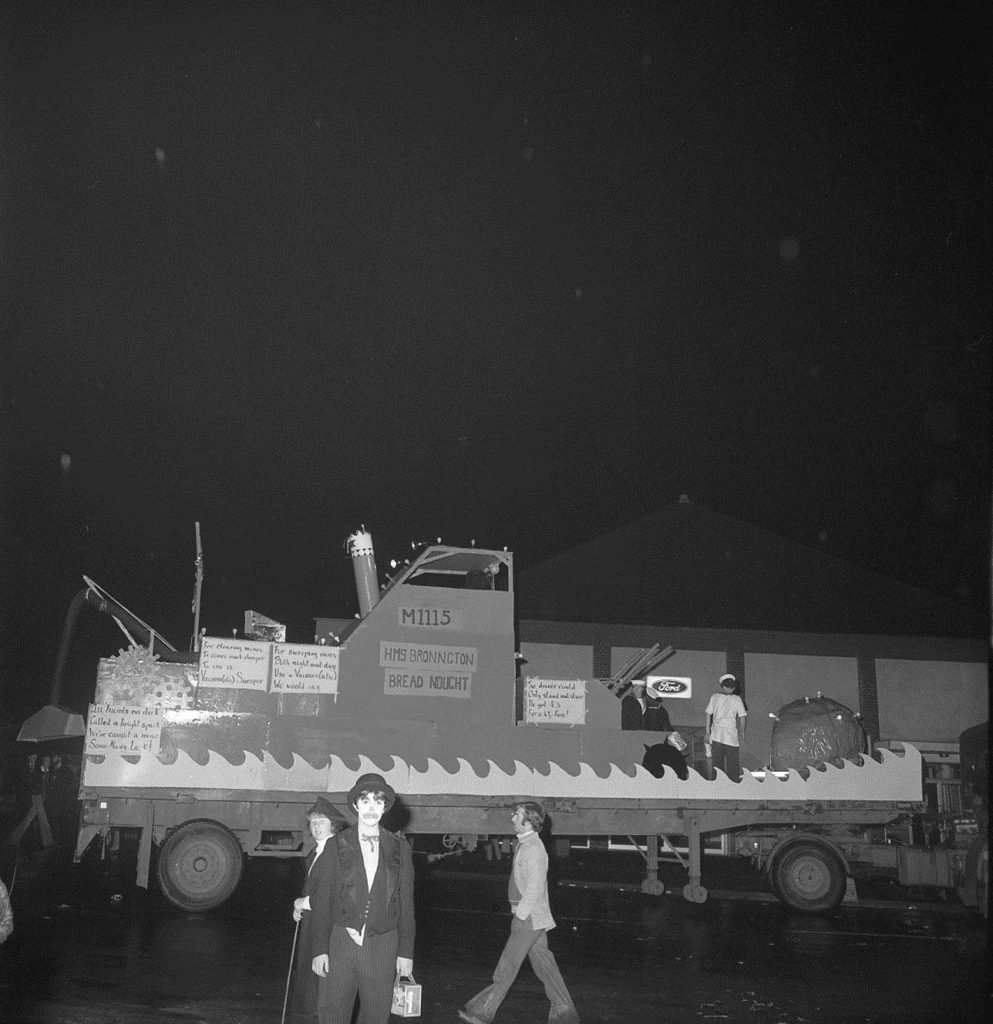
Ladies Circle
1977
Harwich Guy Carnival broke all records in 1977 – despite several floats being blacked out. A number of usually brightly-illuminated Lorries paraded the streets in darkness because generators, which have become scarce during the power cuts, were not available.
But this did not cast a shadow on the proceedings for the crowds who turned out enthusiastically in the rain to line the route.
The Topical Three, who recalled a recent court case, won the Hostler Cup, with the Carnival Dozen depicting the threatened strike by Customs officers in second place and Miss Dale and her Corona fizzicals coming third.
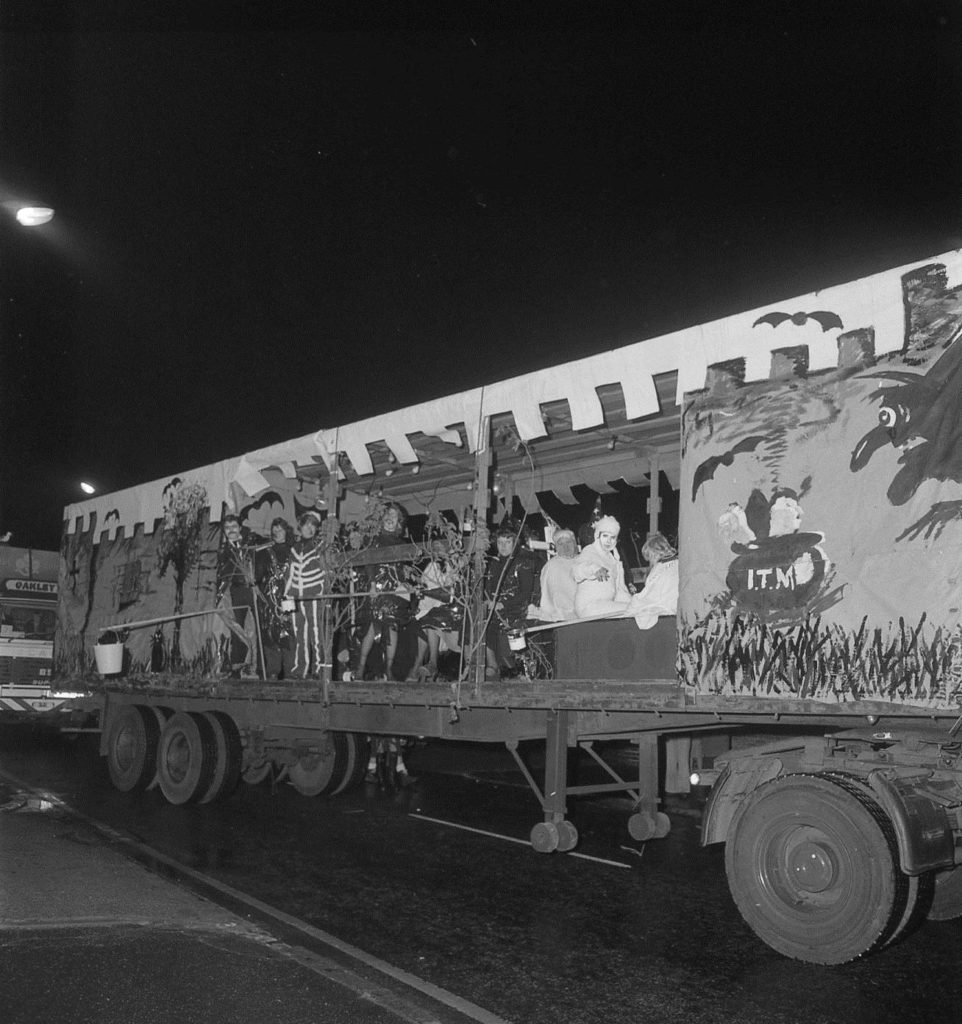
ITM
ITM presented a Halloween Party and made great efforts to be the nosiest float in the procession. They were followed by the prize-winning Guides who spotlighted pollution on Dovercourt beaches, naming the whole affair: “The Anglian Water Atrocity.”
1978
Harwich’s Guy Carnival is not only a night of fun, it is also in aid of a very good cause.
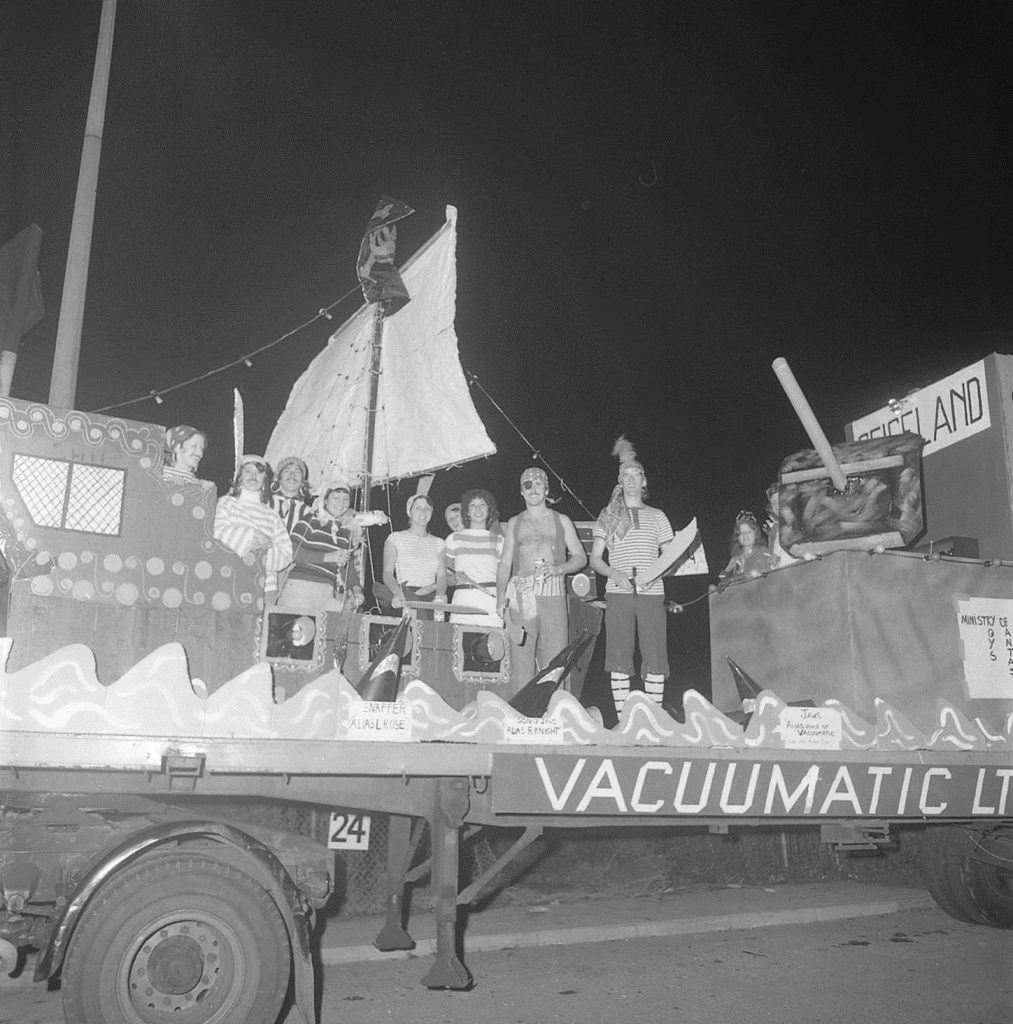
Vacuumatic
1979
The people of Harwich came home late, light-headed and short of loose change after the town’s biggest and most successful Guy Carnival.
Hundreds of cheering men, women and children lined the streets as the traditional procession of gaily-lit floats – with themes from the greenfly plaque to HMS Ganges – wound through the town.
The first float in the procession was fittingly the Harwich Carnival Queen, 18-year old Georgina Blake. She and her two princesses, Sister Sandra and Sharon Cunnew, spent much of the procession practising regal waves.
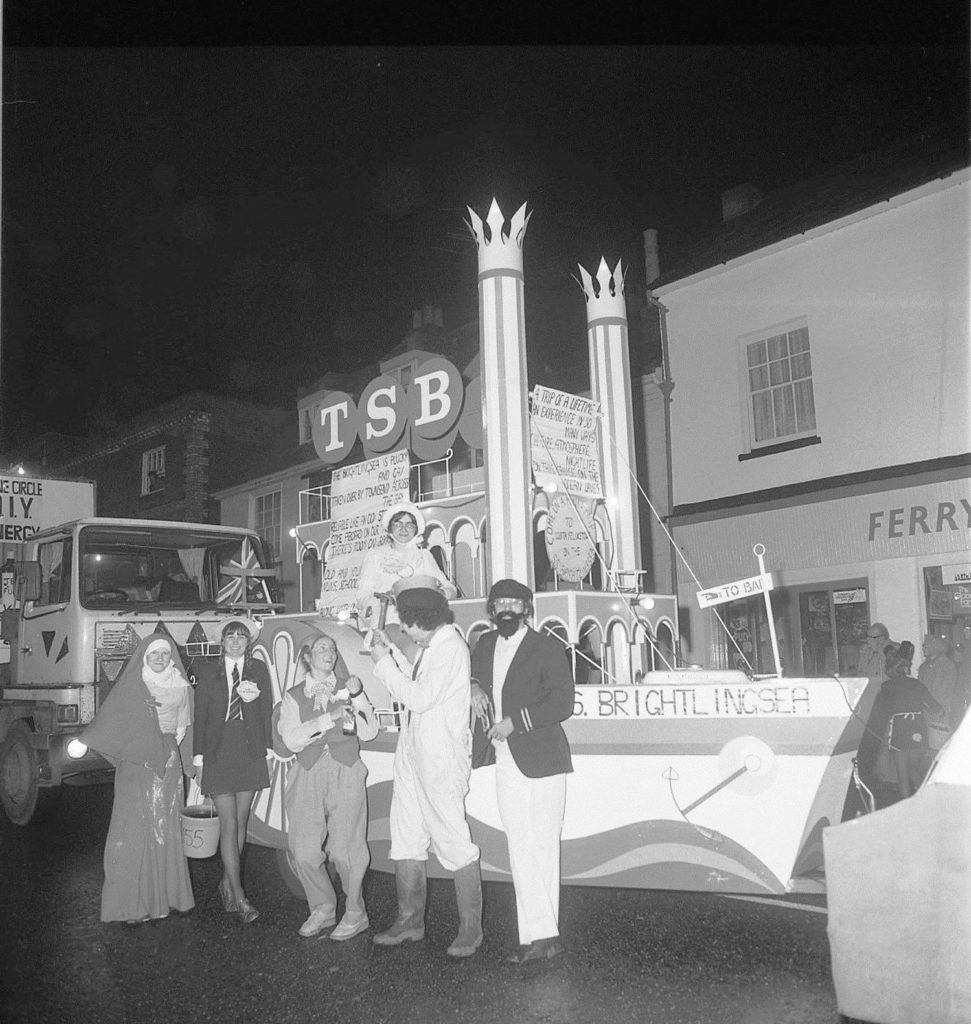
TSB
Trustee Savings Bank branch added a bit of sauciness to the proceedings. Schoolgirls. Tarts and nuns somehow found their way into the theme of the Felixstowe Ferry takeover.
1980
The 1980 Harwich Guy Carnival took to the streets with a record number of floats – despite a relentless freezing cold wind. The 45 entries wound their way slowly around Harwich and Dovercourt and the footpaths were packed with smiling people soaking in the excitement and happiness of those on the floats. The proceeds from the 24th carnival organised by Harwich Round Table – £1,810 from street collections and another £ 490 from raffles and programme selling. Winners of the trophy for local topicality were the Carnival Dozen, their float depicting The Doris, Captain Calamity and crew. British Rail A Shift won the prize for the best large organisation’s float. Their theme was the Mayoress’s Charity Appeal for a new incubator for Harwich Hospital.
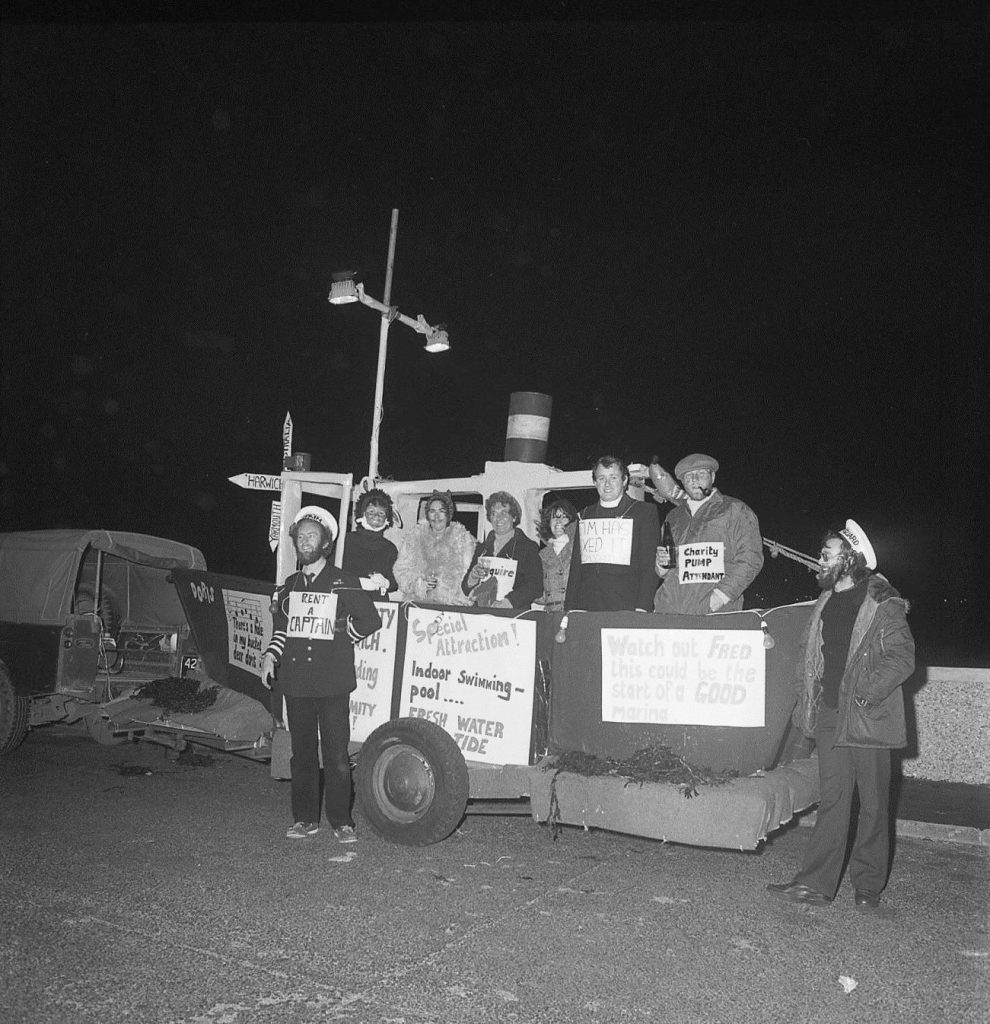
Carnival Dozen – 1980
Parkeston Quay Band.
Made up of the Quay workers. The PQB was established before the Marine Shops Band, and always headed the procession. The Marine Shops band had a position in the middle of the parade, the PQB wore a military style uniform …… red tunic,and blue trousers with a red stripe down the seam. The headgear varied from year to year and ranged from a pillbox to a lifeguards helmet. On the other hand the Marine Shops wore a variety of different costumes. How do I know this? Simply because I was one of the PQB mascots, and paraded with them on numerous occasions. The PQB also had its own social club at the High Street end of Orwell Terrace, and provided a venue for parties and other events.
During the late 30’s the procession was formed up and controlled by two marshals, Alf Fisher and Bill Woodcock,They led the procession, and dressed in naval style Uniform,frock coats ans cocked hats. (c). Royal F.A Moore.
Parkeston Quay Marine Workshops Band
Formed in 1934, the band was originally invented to lead the Harwich summer carnival, and eventually began playing a part in Guy carnivals from 1937. They had their own club, based at the High Street end of Orwell Terrace. They disbanded at the outbreak of World War Two and were around for the beleaguered 1945 Guy carnival, but went on to attend carnivals and events outside the town. The Parkeston Quay Marine Workshops Band saw the 1956 comeback of the Guy Carnival as the perfect chance to show off their big heads.
Like the carnival itself, the band had been out of existence for some time. Jack Horwood was a member of the ‘Stour Wanderers’ band before World War Two, and it was his idea to revive the Marine Shops band (they were in fact the main carnival band as far back as the 1920s and even earlier). The bands’ first new, public engagement was the revived 1956 Guy Carnival. The idea proved more than successful and before 1957’s carnival came around, workers were adding their names to the ever-growing list to join the band. There were 48 members and despite shift-work at the quay, 40 usually turned up at each function. The biggest turn out for the workshops band was 1959, when 44 bandsmen took part in the carnival. Right through the 1960s, Parkeston Quay Workshops band were the main attraction at carnivals, not only Harwich but all over the county. Led by drum major, Ron Avis, they attended functions at Basildon, Colchester, Chelmsford, Harlow, Felixstowe, Southend, Brightlingsea, Witham and Grundisburgh. They even performed for Hollywood star Jayne Mansfield at Ilford in 1959. They had endless engagements and successes. In 1973 drum major Ron Avis, chairman of 12 years, had felt the band needed fresh blood and he stepped down. The band attended 139 carnivals and fetes, and Mr Avis attended 119.
The Harwich and Dovercourt Carnival has proved that live entertainment can bring people out in their masses.
Guy Carnival Gallery
The photos can also be viewed in full screen and as a slide show.
We hope you will enjoy browsing these wonderful photographs, if you have a picture you would like included, please contact us via the contact page.
Acknowledgements: Chris Root, Wendy Taylor, Harwich and Manningtree Standard, Harwich Society.
